

Outback Travellers Guides – Review

These spiral bound guides are full of the kind of detailed track information that many 4WDers on remote tracks would love – everything from bulldust ruts, creek crossings to potential campsites in sand dune swales are covered.
They are perfect for people embracing our philosophy of slow travel, and going deep into a particular location, rather than big ticket, bucket list travellers. I doubt most people would choose these guides if they were simply hiring a car and dashing off to Uluru for a couple days, then flying out again.
Price range: $20-$22 AUD
Who are they suited to: Anyone travelling on 4WD tracks or wanting a lot of fine grain detail.
- Large scale
- Detailed track information such as locations of dips and bulldust ruts
- Original photos
- Regular updates by a very caring author (Greg Walker)
Disadvantages:
- Very small print
- They do not replace the detail found on a website such as this (compare our Alice Springs/Uluru/Oodnadatta Track guides)
- Booklet/strip map format may annoy some people

What they cover (direct links to Outback Travellers Guide site). We have only included the true outback guides in the list below.
- Oodnadatta Track
- Strzelecki Track
- Birdsville Track
- Simpson Desert
- Outback New South Wales
- North Simpson Desert
- Oodnadatta to Alice Springs
- Alice Springs to Boulia
- Binns Track
- Litchfield NP to Darwin
- Kakadu National Park
- Alice Springs to Yulara
- Tanami Road
- The Kimberley
- The Pilbara
- Anne Beadell Highway
- Canning Stock Route
- Googs Track
- North Flinders Ranges
- Great Central Road
- Gunbarrel Highway (map is not the complete Gunbarrel)
- Big Desert – Sunset Country
If you’re looking for minute detail, large scale and precise GPS coordinates, then this series, combined with the much more detailed information on this website, could be what you’re looking for when planning a Simpson Desert crossing or a trip along the Tanami Highway.


Your shopping cart is empty!

- Outback Travellers Track Guides —›
- - Australia
- - Asia Pacific/New Zealand
- - Countries
- - Continents
- - ACT & Canberra
- - NSW State & Sydney
- - NT State & Darwin
- - QLD State & Brisbane
- - SA State & Adelaide
- - TAS State & Hobart
- - VIC State & Melbourne
- - WA State & Perth
- - Huge Wall Maps
- - Local Government Area Maps
- - Folded Maps of Australia
- - Folded World maps
- - Folded Postcode Maps
- - State Maps
- - Touring Maps
- - Visitor Maps
- - NSW Topographic Maps
- - Geoscience 1:50,000
- - Geoscience 1:100,000
- - Geoscience 1:250,000
- - Geoscience 1:1 Million
- - Geoscience 1:2.5 Million
- - Tasmap 1:50 000
- - Papua New Guinea 1:100,000 and 1:250,000
- - Digital Topographic Maps
- - Map Lamination Service
- - Waterproof Paper
- - John Chapman
- - Robert Sloss
- - Spatial Vision
- - ACT and Alpine
- - Other areas
- - New South Wales
- - Northern Territory
- - Queensland
- - Western Australia
- - Canoe and Kayak Maps
- - Caravan & Camping titles
- - Cookbooks
- - Forestry Maps of NSW
- - Leisure & Recreation Books
- - International Road Atlases
- - ITMB / Borch Maps
- - World Maps
- - International - Countries
- - France Regional Maps
- - France Local Maps
- - Green Guides
- - Must See City Guides
- - Adventure Maps
- - Destination City Maps
- - City Maps
- - Pocket Guides
- - Spiral Guides
- - Motoring Atlases
- - World Atlas
- - Laminated
- - Unlaminated
- - Educational
- - Illuminated Globes
- - Inflatable
- - Specialty
- - Perpetual Motion Globes - Mova Globes
- - Perpetual Motion Optional Bases
- - Novelty Globes
- - Four Wheel Drive Guides
- - Central Australia
- - Digital 4WD Products
- - Hema Great Desert Tracks
- - Outback Travellers Track Guides
- - Awesome Classic Maps
- - Street Directories
- - Topographic Maps
- - Hema Navigator System
- - Map and Space Jigsaws
- - Map and Plan Measuring Tools
- - Specials and Markdowns
- - For Schools and Institutions

Outback Travellers Track Guides
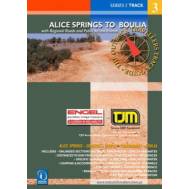
Using photography, track notes and mapping, the Outback Travellers Track Guide is a companion to she..
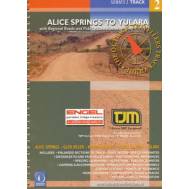
- Camping Cuisine

- Editor's Pick
Travel Guide: Outback Loop
Combine these three classic outback tracks for the offroad adventure of a lifetime…
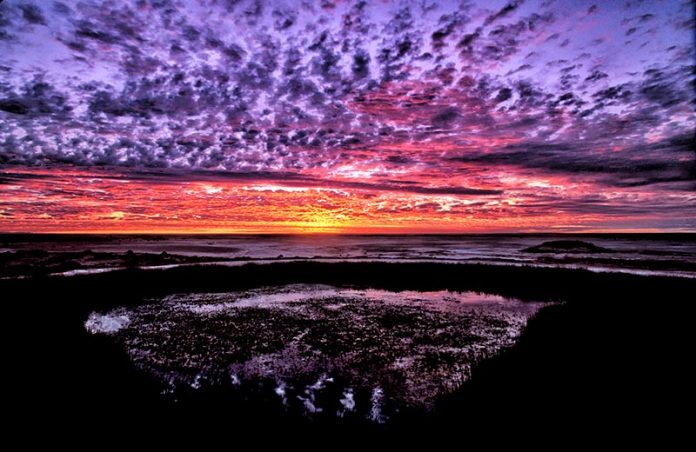
Every offroad RVer in Australia must, at some point, treat themselves to three of the great iconic, historic adventures of the outback: the Strzelecki Track, the Birdsville Track and the Oodnadatta Track. These have now been incorporated into a journey called The Outback Loop ; the printed map (which is not suitable for navigation) and this website, provide a great deal of information, advice and history.
While each track can be done on its own, combining the three into a superb, never-to-be-forgotten desert holiday, makes a lot of sense. Once you come this far, you might as well connect them into a glorious zigzag through the Strzelecki Desert, the Simpson Desert, the Sturt Stony Desert, the Tirari Desert and the Painted Desert.
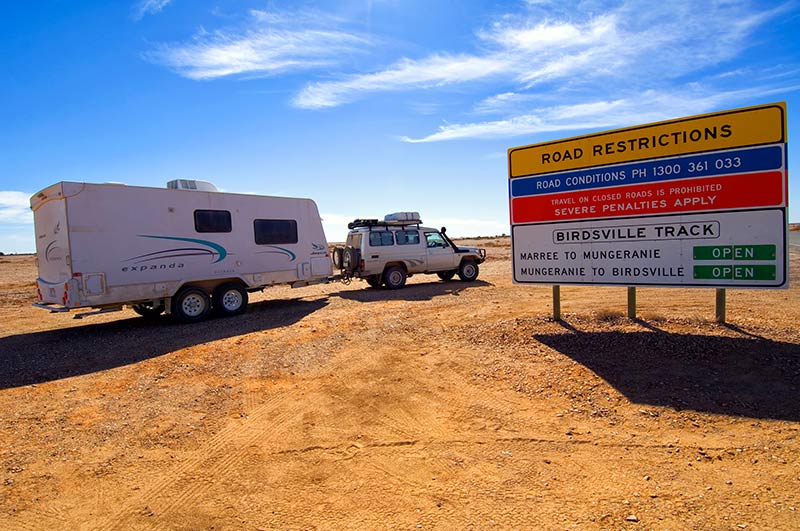
The longest distance without fuel is between Innamincka and Birdsville at up to 525km. If your fuel tank cannot cover this range, jerry cans for spare fuel are required. Stock up on as many groceries and as much drinking water as possible; you will be able to top-up with some supplies along the way, but these are limited. Fill all water tanks and jerry cans in Port Augusta.
An essential task is to stop at the Wadlata Outback Centre where the maps, guides and brochures mentioned below are available along with critical, current track information. If your itinerary includes some of the more demanding optional 4WD tracks, like Walkers Crossing or the Inside (Birdsville) Track, then up-to-date advice is of the essence. The centre’s fascinating, interactive ‘Tunnel of Time’ exhibit introduces the geology, ethnology and history of the region. For those interested in flora and botany, the Australian Arid Lands Botanic Gardens is also worthwhile.
STRZELECKI TRACK
The quickest route from Port Augusta to the start of the Strzelecki is straight up sealed B83. If time is not an issue, it would be a pity to miss the superb Flinders Ranges, Vulkathuna-Gammon Ranges and Arkaroola ( see our Essential Flinders Rangers Guide) . After lingering in Arkaroola, cut west from Balcanoona to Copley.
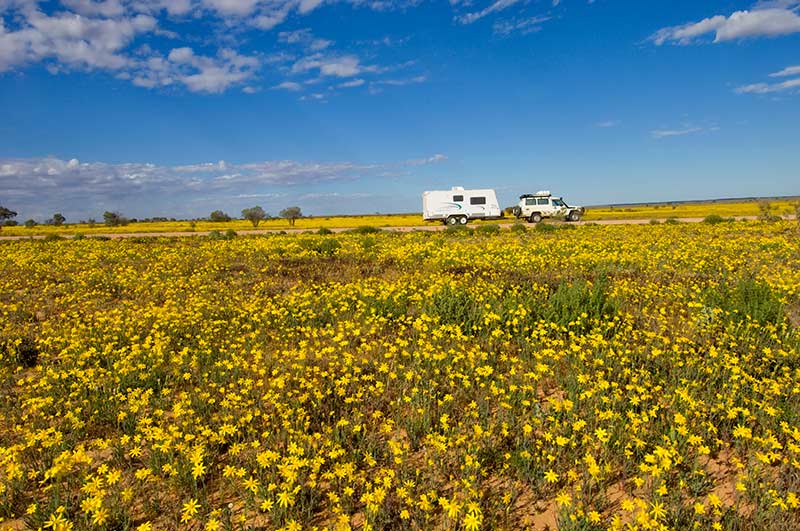
In Copley, stay at The Copley Caravan Park and top up all water tanks; also stop in at the Copley Bush Bakery and Quandong Café to stock up on rock cakes for the journey ahead.
Just 33km north is Lyndhurst and the southern end of the Strzelecki. The original track ran along Strzelecki Creek and was a well-known trading route to the regional Aboriginal groups. Charles Sturt journeyed along it in 1844 on an expedition that nearly killed him.
Augustus Gregory followed the creek for a while on an 1858 expedition to look for Leichhardt, who had vanished a decade earlier attempting to bisect Australia from Brisbane to Perth. The 1860-61 Burke and Wills expedition, with a base camp along the Cooper Creek, killed both those men along with Grey, who died near Coongie Lakes.
The fourth member of the group, King, only survived because he accepted help from local Aboriginals, but he never recovered from the catastrophic ordeal. Memorials to the men, including the historic Dig Tree, can be seen in the Innamincka area.
It was Captain Starlight (Harry Redford) though, a gifted and audacious cattle duffer, who opened up a legendary new stock route in 1870 when he drove a mob of 1000 stolen cattle along the creek to Blanchwater, where he sold the beasts to a station owner for $10,000. He was arrested for his efforts and acquitted by a jury of awestruck peers, going on to lead some of the most famous cattle drives in droving history.
The track no longer follows the creek; it has shifted to the west and now meets the needs of the Moomba gas and oil fields that pump upwards of a million dollars worth of product per day.
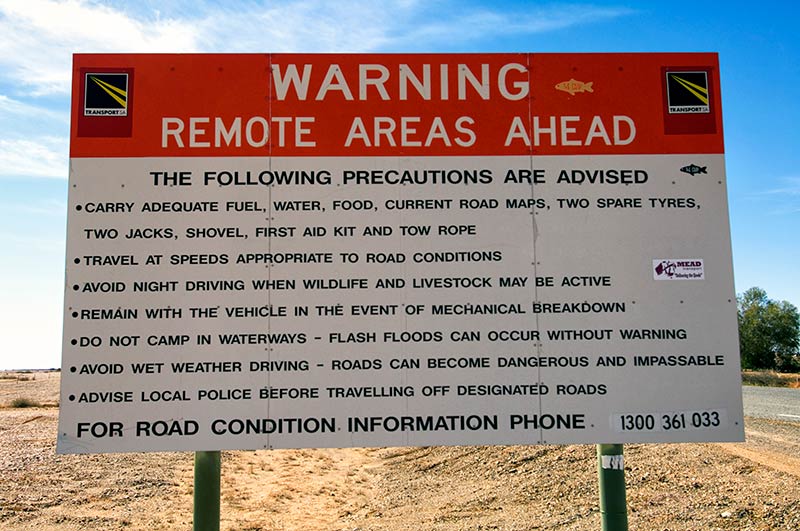
At Lyndhurst, fuel up and turn right onto the track. Road trains and heavy trucks will be sharing the road with you so use extreme caution, especially when clouds of bulldust reduce the visibility to zero. At 26km is a monument on the right: it is a memorial to the early settlers and not-so-early travellers who have perished in the area.
Mount Lyndhurst Homestead and then a bore follow – take it easy through the Frome Creek and Tent Hill Creek floodways. The Mount Fitton Talc Mine turn-off is on the right at 80km.
A series of floodways and cattle grids follow, along with signs for station homesteads. At 197km is a right turn to Arkaroola and Vulkathuna-Gammon Ranges National Park (151km to Balcanoona). Heed the ‘wandering stock’ signs.
At 210km is the Art Baker Lookout, a rest area on the right that makes a perfect cuppa break. If you are looking for a one-night bushcamp, continue for another 12km to the Montecollina Bore Campground.
The Strzelecki Creek Floodway is at 276km, and this is a great spot for a break under the shade of a river gum tree (do not camp under these as they sometimes drop heavy branches). While the track looks pretty smooth on up to Moomba, the shoulders are soft and there can be deep potholes camouflaged by bulldust.
The turn-off on the right to Merty Merty Homestead (the Old Strzelecki Track), Bollards Lagoon Homestead (the Bore Track) and Cameron Corner is at 320km.
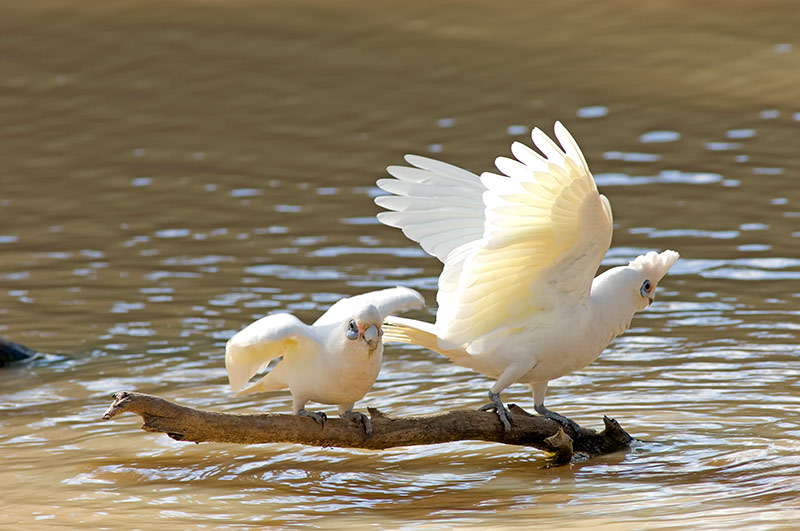
From this point, there are a number of gasfield tracks branching to the right and left. All of these are private, as is the turn-off to Moomba at 370km. Veer right and at 427km branch left for Innamincka, with another 3km to ‘town’.
Innamincka Regional Reserve is a true outback wonder. Aside from the history, it is screaming with birdlife, most of it drawn to the Cooper Creek. Entry fees and camping permits are required for the reserve and Milkumba-Coongie Lakes National Park .
The Trading Post has daily entry and camping permits for both. To camp beside Cooper Creek, take a left on Fifteen Mile Track and continue to at least the second right to the Town Common Campground. This is the closest to the showers (in ‘town’) and the departure point of the must-do Cooper Creek Cruise (sign up at the Innamincka Hotel ).
There are six campgrounds (four with drop toilets) along the creek, and you must book in advance . There is also camping at Cullyamurra Waterhole and Dig Tree (drop toilets only).
So, what is there to do? Visit the memorials to King and Wills, also to Burke (8km) east via Nappa Merrie-Dig Tree Road, and to the Burke and Wills Dig Tree 67km further. Visit or camp at Coongie Lakes. Do some birdwatching or even fishing along the Cooper Creek.
For the 4WDer, there is the Old Strzelecki Track and the Bore Track to rattle your bones and coat you in dust.
516km Lyndhurst to Innamincka, no fuel in between.
Leigh Creek and Copley have fuel, tyre and mechanical repairs, and limited supplies. Lyndhurst has fuel. Innamincka has fuel, tyre and mechanical repairs and limited supplies.
Innamincka Regional Reserve – Park Map
Innamincka Regional Reserve – Innamincka surrounds map
Malkumba-Coongie Lakes National Park map (pdf)
INNAMINCKA TO BIRDSVILLE
It is not easy to leave Innamincka, certainly one of the highlights of The Outback Loop, but at some stage one must. Top-up your fuel tank, re-stock supplies with whatever is available at The Trading Post, ask for track conditions ahead, and head north on the Cordillo Downs Road through the gorgeous Innamincka Regional Reserve.
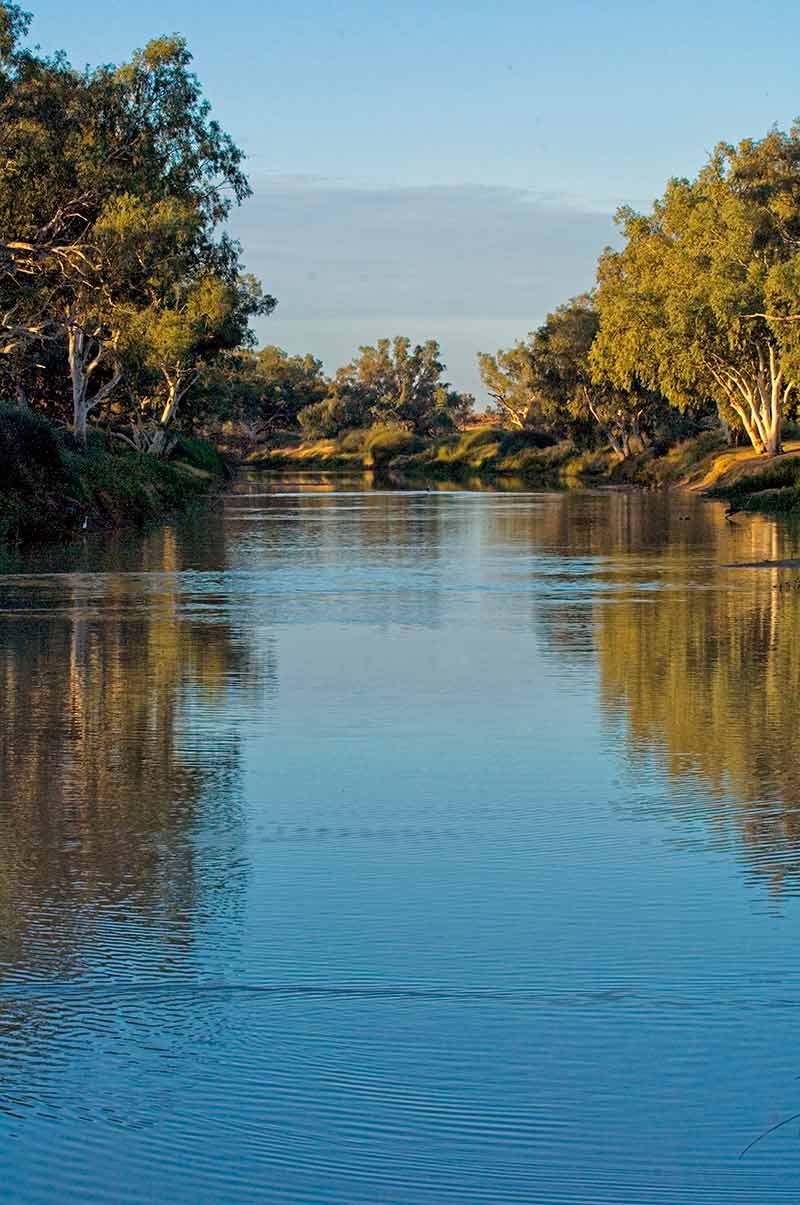
There are a number of narrow cattle grids and sandy creek crossings/floodways, but a true offroad camper trailer or caravan can be towed with care. There are numerous scenic places along the first 141km to stop for a rest or even a one-night stay.
The road will fork: to the left is a shorter but far rougher track via Cordillo Downs. This option is not suitable for caravans and extreme caution should be used at all creek crossing and floodways, especially at Providence Creek.
To the right is the longer and not-as-rough Arrabury Road: continue east for another 16km and turn left (157km from start); you are now in Queensland with a 30-minute time change (back). At 287km is the Birdsville Developmental Road; turn left.
If you are yearning for a rest or a nighttime stopover, there is a lookout area (with no facilities) at 316km on the right. The track via Cordillo Downs enters on the left at 393km and there is a rest area with toilets on the left at 414km. The road staggers through a series of dunes toward the end where it is impossible to see oncoming vehicles. At 509km, you will arrive – dazed, confused and relieved – at Birdsville.
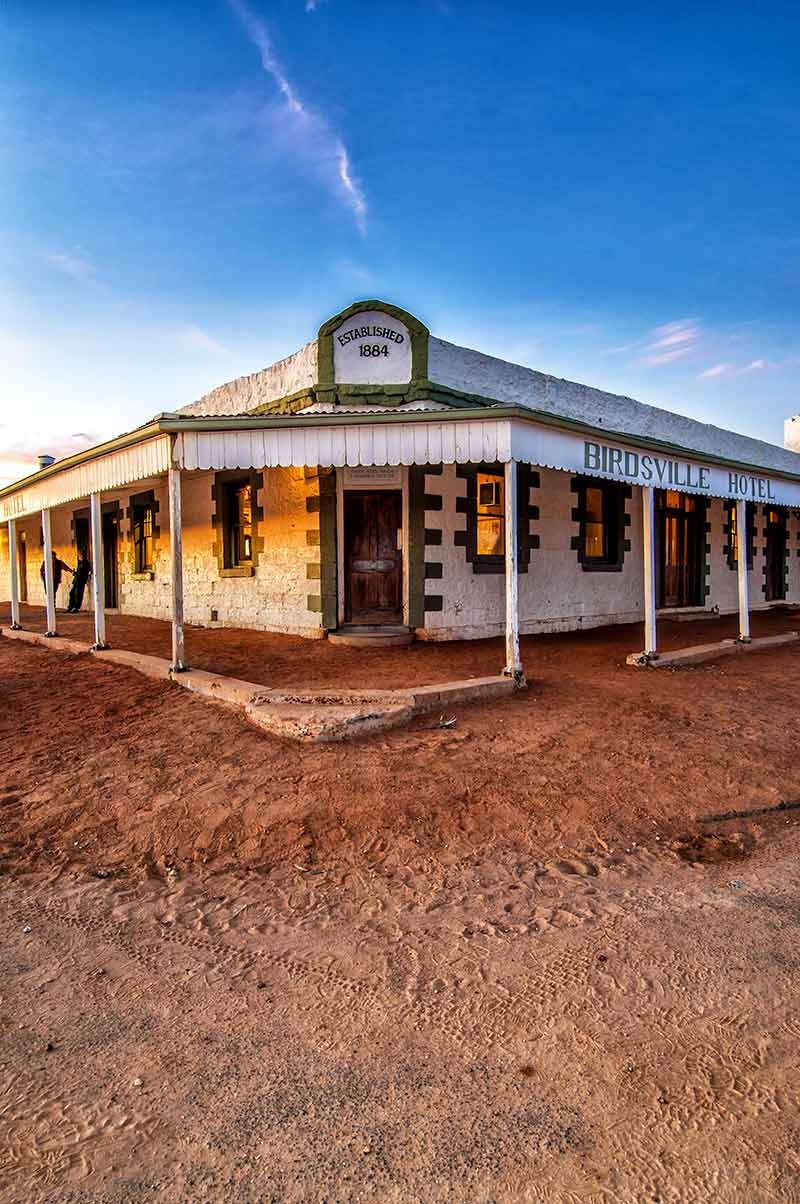
The Birdsville Caravan Park sits across from the Birdsville Roadhouse where windshield repairs (front and back) and tyre repairs are wildly lucrative for the owners. There are powered campsites, and further down by the Diamantina River are unpowered sites. Of course, it is mandatory to wander over to the Birdsville Hotel for a beer.
The Wirrarri Visitor Information Centre offers up-to-date information on the tracks; this is of particular importance if you plan to travel on the Inside Track. Every visitor will want to take the 34km track west to Big Red, the highest and most easterly dune on the Simpson Desert crossing from Mount Dare to Birdsville, and a superb spot from which to watch the sunset.
If you love chaos and mayhem, be in Birdsville in the first week of September for the Birdsville Races when the population of 100 soars to a bulging 5000. Other things to do include a scenic flight if the budget permits.
Distance: 417km via Cordillo Downs Road and Birdsville Developmental Road.
509km via Cordillo Downs Road, Planet Downs and Birdsville Developmental Road.
512km via Dig Tree, Arrabury and Birdsville Development Road.
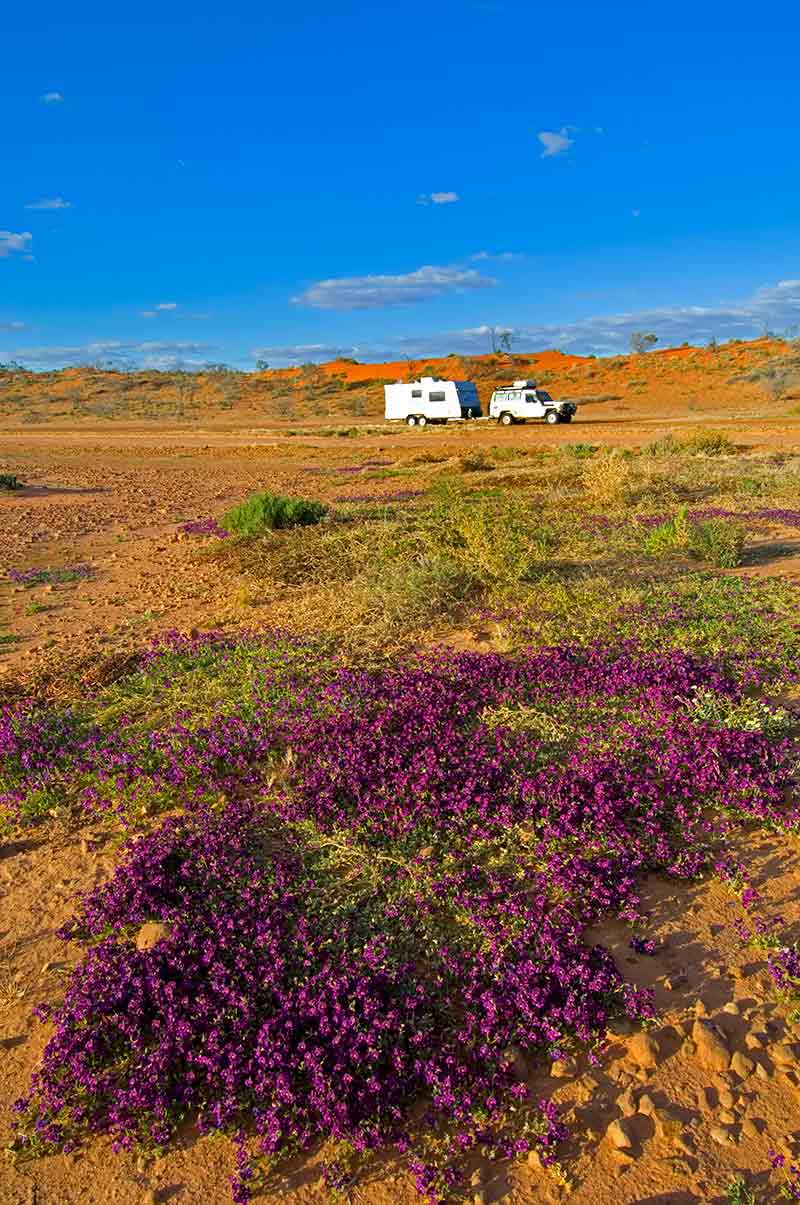
228km track via Walkers Crossing with another 104km to Birdsville; experienced 4WDers in a convoy of at least two with full recovery gear, emergency supplies, excellent navigation skills, long-range radio or satphone and a printed map. Watch for confusing mining tracks and a deep, steep crossing at Walkers Creek.
Supplies and fuel: Innamincka has fuel, limited repairs and supplies. Birdsville has tyre and mechanical repairs, fuel and two stores with some (very expensive) supplies. There is no fuel available between Birdsville and Innamincka.
BIRDSVILLE TRACK
And so, onto the Birdsville Track. In the past, cattle were driven along routes fanning out across the top of Australia and feeding down through the Channel Country, considered some of the best ‘fattening up’ land in the world.
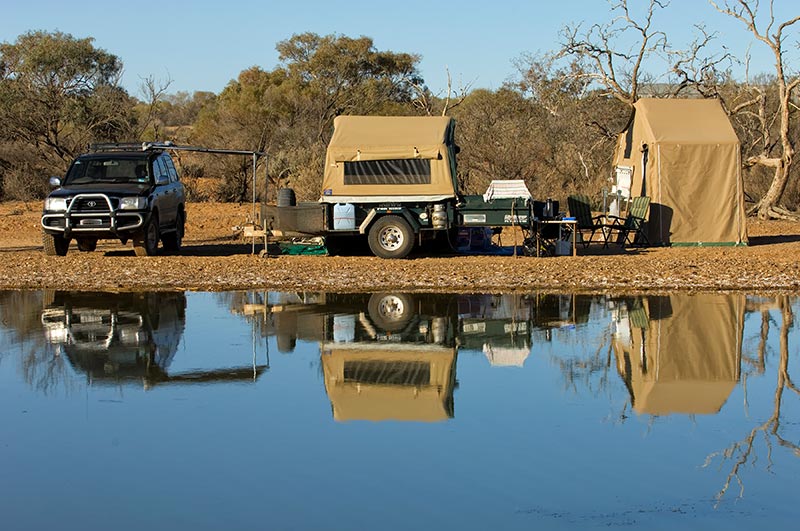
At Birdsville, these routes drew into one for a final 500km push to the railhead in Marree where cattle trains transported the beasts to Adelaide and Melbourne. By opening up this old Aboriginal trading route in 1870, drovers with their horses and dogs led an isolated life over the following century under a relentless blue sky that was dusty, hard and free from all modern inconveniences.
To water the drovers and cattle, bores were sunk into the Great Artesian Basin. The drovers and their families took up leases along the track that they still hold to this day. Afghan traders leading camel trains also used this track and the Oodnadatta to supply those families. The mail run from Marree to Birdsville, along the Inside Track, was one of the most gruelling in the land with, among others, a mailman known as Tom Kruse. The Birdsville, then, helped to build the nation.
Top-up your water tanks and jerry cans at the caravan park. Stock up with whatever goods are available at the two small stores. For experienced 4WDers with full emergency gear and only towing a true offroad camper trailer or tenting it, the Inside Track offers more of a challenge along the same mail run mentioned earlier. Otherwise, head down the main track to the racecourse and Betoota junction and continue straight.
Use extreme caution through the dunes as oncoming vehicles are not visible. At 30km is the Pandie Pandie airfield; you have crossed the border back into South Australia and watches should be set forward by 30 minutes.
Take it easy through floodways and over cattle grids; the Walkers Crossing track enters on the left at 124km and 14km further is Lake Surprise Creek, a nice spot for a rest.
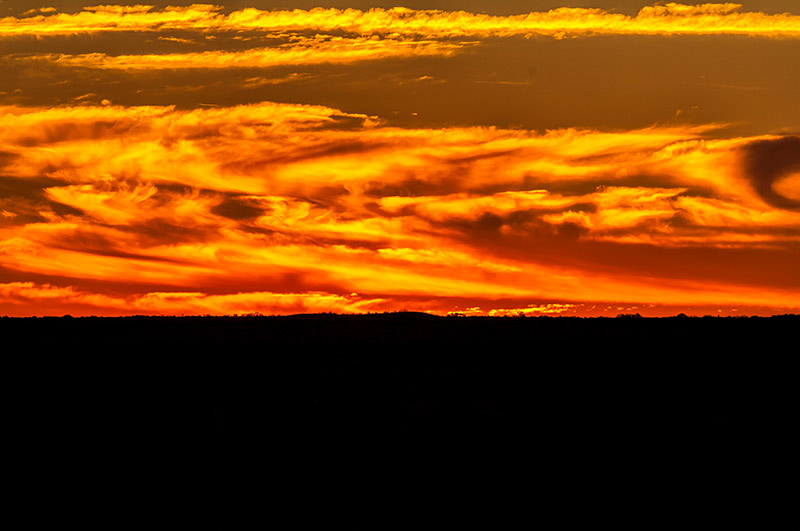
The Inside Track enters on the right at 183km (do not expect to see a sign for this); the Warburton Track enters on the right at 208km. After that, it is a fairly easy run, with several floodways and the Mirra Mitta bore wetland to brighten the scenery.
Wonderful Mungernie is at 317km, a delightful spot for one of those one-night stopovers that easily turns into two or three.
The pub serves meals and the artesian spa will melt away those rattled bones and muscles. Birdlife abounds, including brolgas, flocks of corellas and migratory waders dropping by for a feed. Mungeranie has to be the highlight of the entire track.
Picking up the track again, at 356km is a short jaunt on the right to the Old Mulka Ruins. One of those historic families, the Scobies, ran cattle and bred whalers here, the breed of horse that was used by diggers in the 1917 Australian Light Horse Brigade.
Further south at Clayton Station, one of the grandsons still breeds and trains those horses. The Cooper Creek Floodway starts at 377km and continues for 5km along a section of track that is impassable in rain and flooding. Take it easy through the following floodways until Clayton Station at 469km.
Even if you don’t camp here, stop for a look at the Clayton River Wetland about 500m west of the campground and maybe take some time for an artesian hot tub. A failed date farm at Lake Harry is on the left at 492km and Marree is at 522km.
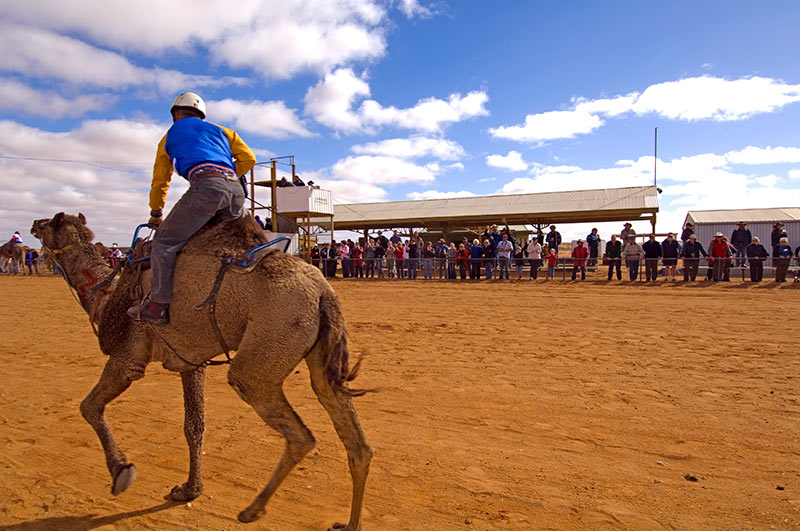
In the past, the greatest delight about visiting Marree was staying at the Drovers Rest Tourist Park and having a yarn with the owner, Eric Oldfield. Eric was a legend on the Birdsville; he was a drover for many years and once owned Mungeranie. The Oldfields, along with the Scobies, were as much a part of the track as the landscape.
Eric died in late 2010, and for us, Marree will never be the same. Today, Drovers Rest is now Drovers Run, with a second park called the Marree Caravan and Camping Park.
There are a few things to do in Marree; for ideas, visit the Aussie Towns website. The pub serves a great steak sandwich with the lot. If it is July and the Marree International Australasian Camel Cup is on, don’t miss it. You might even meet members of the families living along the Birdsville Track.
Distance: 521km, fuel at Mungeranie.
426km via Inside Track, experienced 4WDers with full recovery gear and emergency supplies, not suitable for caravans, serious off road camper trailers only. Carry a printed map suitable for navigation. Check on track conditions at the visitor centre.
Supplies and fuel: Birdsville has fuel, tyre and mechanical repairs, fuel and two stores with some (expensive) supplies. Mungeranie has fuel, tyre repairs, and great hamburgers. Marree has fuel, tyre repairs and limited supplies.
OODNADATTA TRACK
Fill up with fuel and pick up a copy of Travel the Oodnadatta Mudmap and Route Notes ; there are more mudmaps on the website that correspond with a number of round, pink signs along the way.
Head north up the Oodnadatta; this track, like the other two, was once an Aboriginal trading route and indeed home to many groups who lived along the chain of mound springs bubbling up along the rim of the Great Artesian Basin.
John McDoual Stuart journeyed along it between 1860-62, plunging north toward Finke. The Overland Telegraph Line was plotted in 1871 along Stuart’s route.
Ernest Giles was next in 1876, and in 1890 the Old Ghan Railway was linked on from Adelaide to Marree to Oodnadatta.
As you travel, there will be numerous historic sites to stop at along the way, making the journey much more interesting. Expect sandy conditions, heavy corrugation and sharp rocks through rough floodways.
A track to Hergott Springs is within the first kilometre; this is followed by hundreds of springs branching north. At 3km is the 51km track to Muloorina Campground , a fabulous spot to spend a couple of nights.
The 45km, 4WD-only Level Post Bay Track continues to the edge of Kati Thanda-Lake Eyre National Park ; leave the camper trailer at the campground if attempting the track (this adds up to 192km to the trip so either return to Marree for fuel, or be sure you have enough to make it to William Creek).
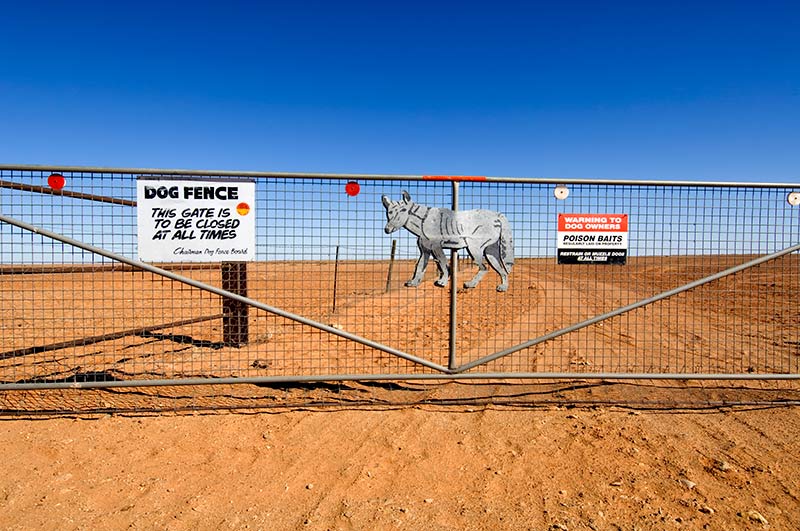
Excluding the track to Muloorina in this kilometre count, continue past the floodways and historic siding ruins of Callanna, Wangianna and Alberrie. The turn-off on Borefield Road to Roxby Downs is on the left at 69km and Screech Owl Creek floodway follows in 4km. At 92km is an information bay and lookout for Kati Thanda-Lake Eyre South; stop to gaze over a massive pan of sparkling white, or in flood years, a lake with water in it. The Curdimurka and Margaret railway sidings follow.
It would be silly to miss the Wabma Kadarbu Conservation Park at 126km to see Blanche Cup and The Bubbler mound springs. Another 6km brings you to the delightful Coward Springs Campground , a superb spot with an artesian spa, a wetland, a historic siding complete with a restored cottage and Ghan museum, and camel treks. A night or two here is a must, with a return to the mound springs for sunset.
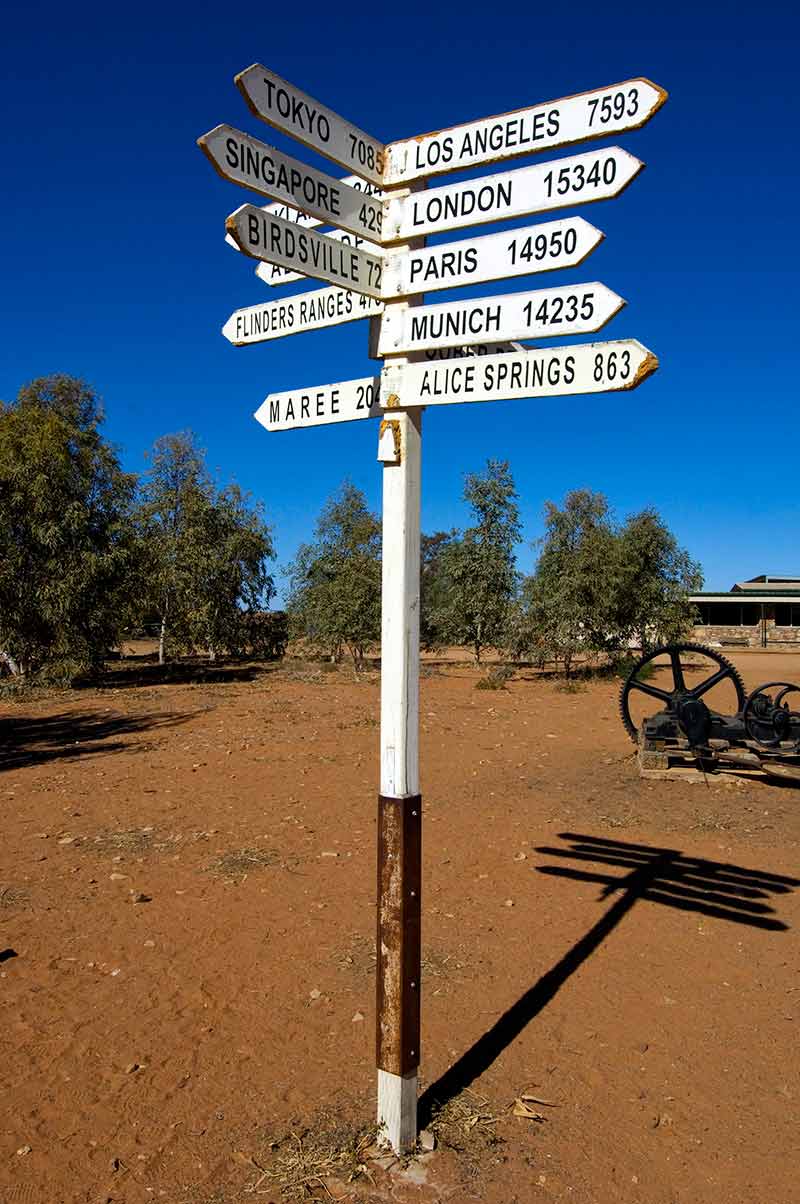
More historic sites continue, with Beresford Bore Siding and Strangeways. The ABC-Halligan Bay Track enters on the right at 198km; this is a 64km, strictly 4WD-only track to Kati Thanda-Lake Eyre: a Desert Parks Pass or a daily permit from the William Creek Hotel is required. The hotel is 7km further at 205km.
Fuel is available at William Creek, along with camping, meals, camel tours and scenic flights .
The William Creek Road enters 5km further on the left, with a rough 168km west to Coober Pedy.
The Oodnadatta Track often deteriorates after William Creek, so use caution through the floodways. More historic sidings follow, with Edwards Creek (294km), Warrina and Algebuckena at 348km, with a parking pull-out and rest area near a railway bridge and siding.
The track to Allendale enters on the right at 387km. The Hanns Creek floodway is followed by the North Creek floodway at 369km, a nice camping alternative to Oodnadatta. The track splits at 401km; turn right and Oodnadatta is at 407km. Fill up with fuel and whatever supplies are available at The Pink Roadhouse .
The actual Oodnadatta Track continues for 211km to Marla on the Stuart, or you can continue north to Mount Dare and Dalhousie Springs in Witjira National Park (the track deteriorates further and caution is required).
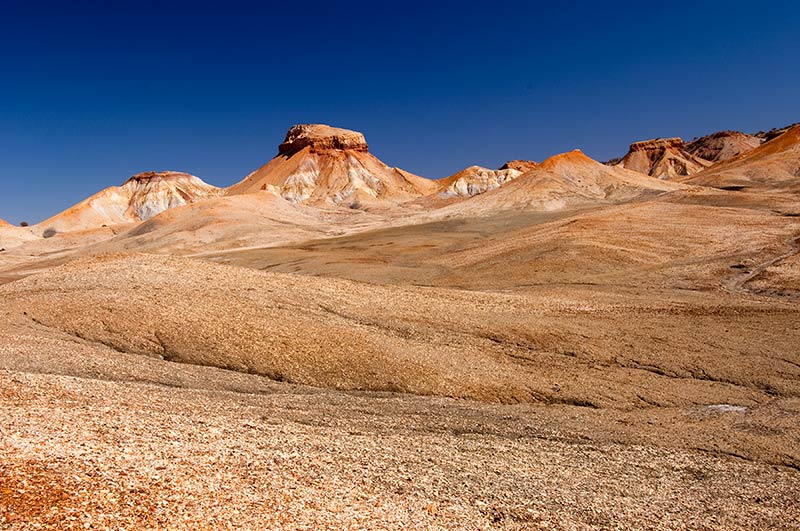
A much prettier route than the one to Marla is via The Painted Desert to Cadney Park on the Stuart. Linger through the magnificent scenery, and if possible spend a night camping at the Arckaringa Homestead to enjoy a sunset or sunrise over the desert. For this, turn west 6km south of Oodnadatta on the road to Coober Pedy. Travel southwest for 45km, turn right and continue toward Arckaringa and through the Painted Desert for 41km. Veer right toward Stuart Highway and proceed 34km, turn right toward Copper Hill and Cadney Park, continue for 36km, and then make a sharp right with 12km to the Stuart Highway.
From the Stuart it is either a right or left-hand turn. Regardless of your intended direction, this adventure along The Outback Loop is one you will never forget, and, one you can dine out on for many years to come.
Distance: 407km Marree to Oodnadatta, fuel at William Creek.
Add 108km return side trip to wonderful Muloorina Station with another 90km return track to Lake Eyre.
Supplies and fuel: If you are running short on food, you can take a run down to Leigh Creek and stock up on supplies at the Foodland – phone (08) 8675 2009 to make sure they are open and have the items you are looking for.
Marree has fuel, tyre repairs and limited supplies. William Creek has fuel, tyre repairs and meals. Oodnadatta has fuel, tyre and mechanical repairs, with limited supplies.
Kati Thanda-Lake Eyre National Park map.
Witjira National Park map.
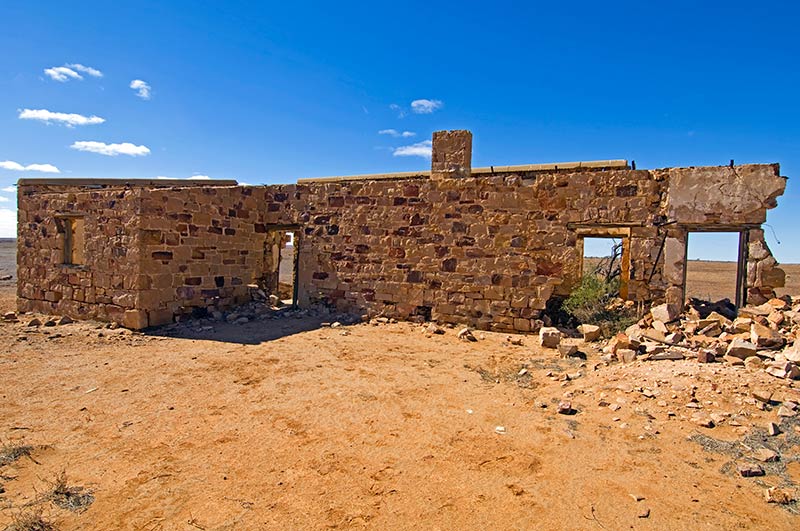
GENERAL INFORMATION
Public-access roads pass through private stations; any travel on private tracks requires prior permission.
Camping is prohibited within a radius of 1km of any building, or a radius of 500m of any dam or stock watering source, or within 10km of a commercial campground. Camping is permitted within 50m of any public-access road.
If towing, protect your rear windscreen from stone damage. Corrugated plastic sheets cut to cover the rear window can be made in advance, or order pre-made kits from Plasweld . In a pinch, sturdy cardboard and duct tape will do.
Fully protect PVC fittings, pipes, water tank and wiring on the undercarriage of your off road camper trailer or caravan. Expect stone damage.
A bit more about the pubs on The Outback Loop.
Never rely solely on GPS navigation. Carry a sheet map such as:
The Desert Parks Pass with maps, historical and environmental information; the pass is not required for Strzelecki, Birdsville and Oodnadatta Tracks.
The Outback Travellers Track Guide Series 1 : Oodnadatta, Strzelecki and Birdsville Tracks.
Westprint Birdsville & Strzelecki Tracks , also Oodnadatta Track .
Comprehensive supplies in Port Augusta. Scripts and medical supplies are not available anywhere else. Carry a first aid kit.
Limited supplies are available along the way.
No banks, though some banks trade through Australia Post agencies at Leigh Creek and Birdsville. Most businesses accept EFTPOS but do not give cash back.
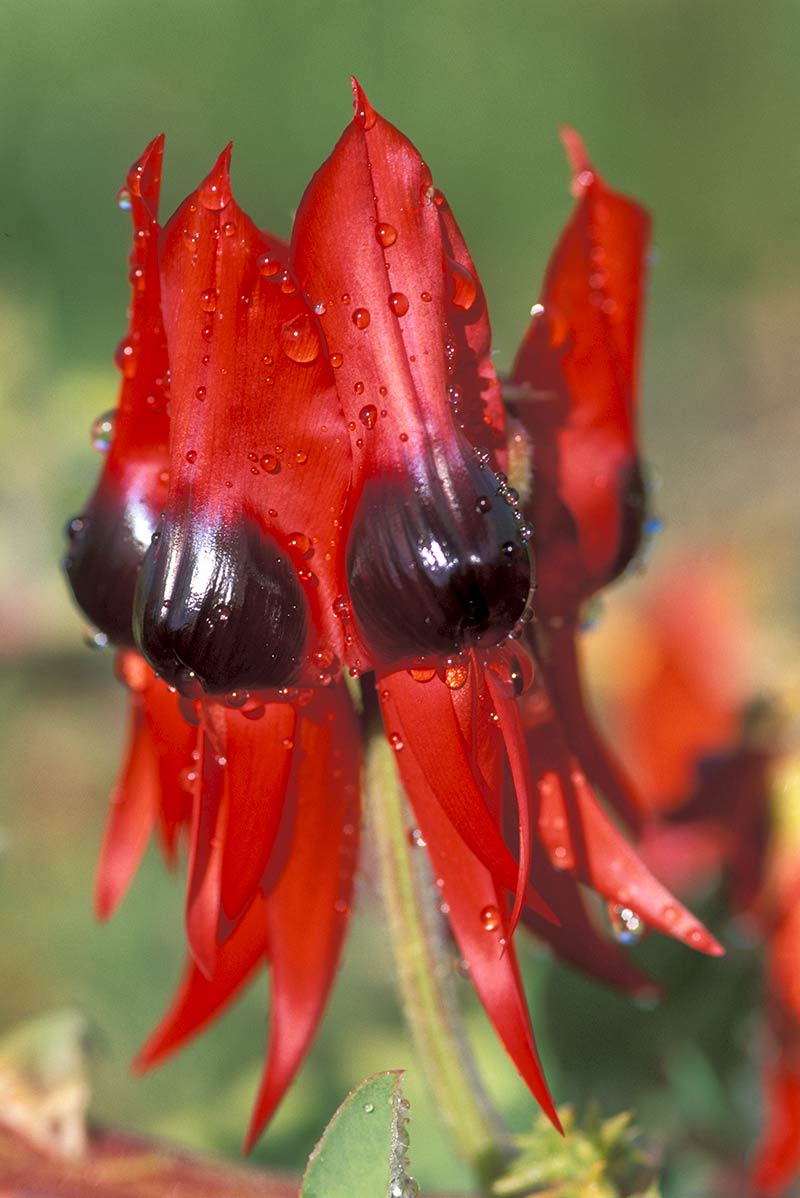
INFORMATION
Visit S.A. National Parks & Wildlife Service . Download PDF documents and maps of interest including the Desert Parks Bulletin.
Drop by the Wadlata Outback Centre in Port Augusta for essential track information. Also pick up a hard copy of:
Flinders & Outback Visitor Guide
4WD Tracks & Repeater Towers brochure .
National park brochures.
The Outback Loop map
VEHICLE RECOVERY
RAA in South Australia: phone 13 11 11.
MOGAS Cookes Outback Motors in Copley: phone (08) 8675 2618.
Birdsville Roadhouse RACQ: phone (07) 4656 3226.
Pink Roadhouse Oodnadatta: phone 1800 802 074.
VEHICLE RECOMMENDATIONS
Any 4WD with high clearance. Vehicle must be in perfect mechanical condition. Drop the psi slightly on all tyres (vehicle and RV) to minimise damage from stones.
UHF radio. Duplex channels 1-8 and 31-38 are for emergency purposes only.
Offroad caravans or camper trailers are fine if towed with caution along the main tracks and the Painted Desert.
For your sake and the sake of others, drive to conditions and slow down for approaching vehicles so you don’t throw up stones and cause expensive windshield damage.
Images: Steven David Miller / Natural Wanders
RELATED ARTICLES MORE FROM AUTHOR
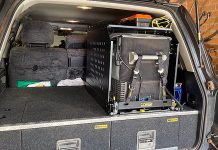
Caravan 12V Issues Solved!
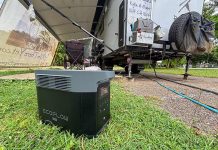
Review: EcoFlow Delta 2 Max Lithium Power Station
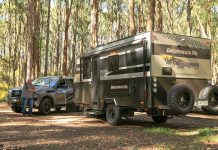
Goldstream RV 1760 RE CD Rhino Caravan Review
Leave a reply cancel reply.


Series 4 Track
- Googs Track
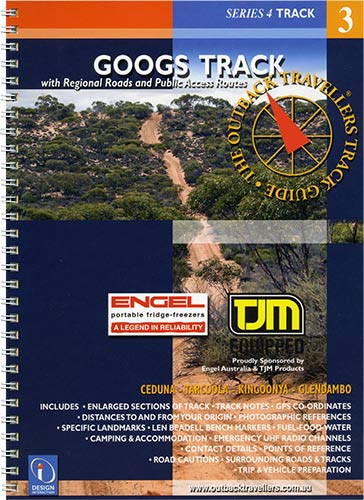
Googs Track was built by 'Goog' and 'Dinger' Denton along with Denis Beattie (Jenny Denton?s brother) from June 1973 through to August 1976. A mammoth task by men with a true pioneering spirit. The track today provides 4 Wheel drivers with a great means to seek adventure and experience a virtual 'mini' Simpson desert. Travelling over roughly 300 sand dunes climbing up to 25 metres, will test your driving skills with sand whilst taking in some pristine country through the Yumbarra Conservation Park and Yellabinna Regional Reserve. Googs Lake and Mt Finke offer popular camping locations with a relaxing environment. Although travel from South to North is recommended, this is a two-way track and drivers need to be aware of on-coming 4wds.
Impressions

Unique Visual Reference
For the traveller & explorer.
The Sectioned Maps will help you find everything of interest along the Track and point out potential road cautions in advance, supported by visual references, for the benefit of your safety. All Regional Roads and Public Access Routes. Full colour throughout. Colour coded track information indicating dips, crests, creek crossings, floodways, sharp bends, grids, gates, bogs, homestead tracks, historic sites. Photographic views, geographic locations, towns and services.
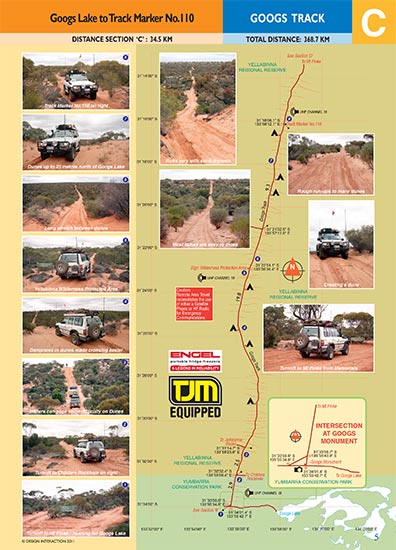
NEW! Digital Map Guides
Now available from the Avenza online shop in PDF format for usage on tablets, smartphones and Powerbooks.

- About Outback Travellers Track Guide
- Trip Preparation
- Birdsville Track
- North Simpson Desert
- Oodnadatta Track
- Outback New South Wales
- Simpson Desert
- Strzelecki Track
- Alice Springs To Boulia
- Alice Springs To Yulara
- Binn's Track
- Litchfield N.P. To Darwin
- Kakadu National Park
- Oodnadatta To Alice Springs
- Tanami Road
- The Kimberley
- The Pilbara
- Anne Beadell Highway
- Canning Stock Route
- North Flinders Ranges
- Great Central Road
- Gunbarrel Highway
- Gulf Savannah Country
- Tibooburra to Mount Isa
- Big Desert - Sunset Country
- Davies Plain
- Snowy River
- The Grampians
- The Otway Range
- Wonnangatta
- Terms & Conditions
- Privacy Policy
TRACK US DOWN
T + 61 3 5952 1407
M + 61 419 882 717
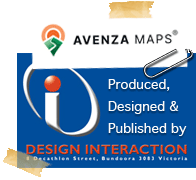
Copyright © 2006-2022 Design Interaction | Site by ad creatives
- Science & Environment
- History & Culture
- Opinion & Analysis
- Destinations
- Activity Central
- Creature Features
- Earth Heroes
- Survival Guides
- Travel with AG
- Travel Articles
- About the Australian Geographic Society
- AG Society News
- Sponsorship
- Fundraising
- Australian Geographic Society Expeditions
- Sponsorship news
- Our Country Immersive Experience
- AG Nature Photographer of the Year
- Web Stories
- Adventure Instagram
Home Australian Geographic Adventure Outback travel: The ultimate family guide
Outback travel: The ultimate family guide

When we think ‘outback’, the iconic image is that of the red sand of Australia’s desert country. But, it also covers the remote tropical regions of Oz as well – think: Cape York, Kakadu, the NT/QLD Gulf Country and WA’s mighty north-west (encompassing the Kimberley and the Pilbara regions). By themselves, Australia’s deserts account for an estimated 70 per cent of the continent’s land mass. Pretty impressive, but not half as impressive as actually getting out there and exploring and camping in one (or more) of them. Nothing beats that sense of utter remoteness offered by the combo of an endless red, sandy horizon, topped by the blue skies synonymous with this country’s desert regions.
The attractions of outback touring go beyond that sense of isolation and remoteness and also take in the rich ties this landscape has with all Australians, whether it is the eons-old indigenous culture, or the more recent European explorers’ history. It is this sense of retracing the steps of early explorers that is one draw for visitors. This, in turn, is further enriched by the chance to experience that ‘sense of place’ so ingrained in Indigenous culture – along with the physical reminders of their long and continued residence here, in the form of reliable waterholes, petroglyphs, etc.
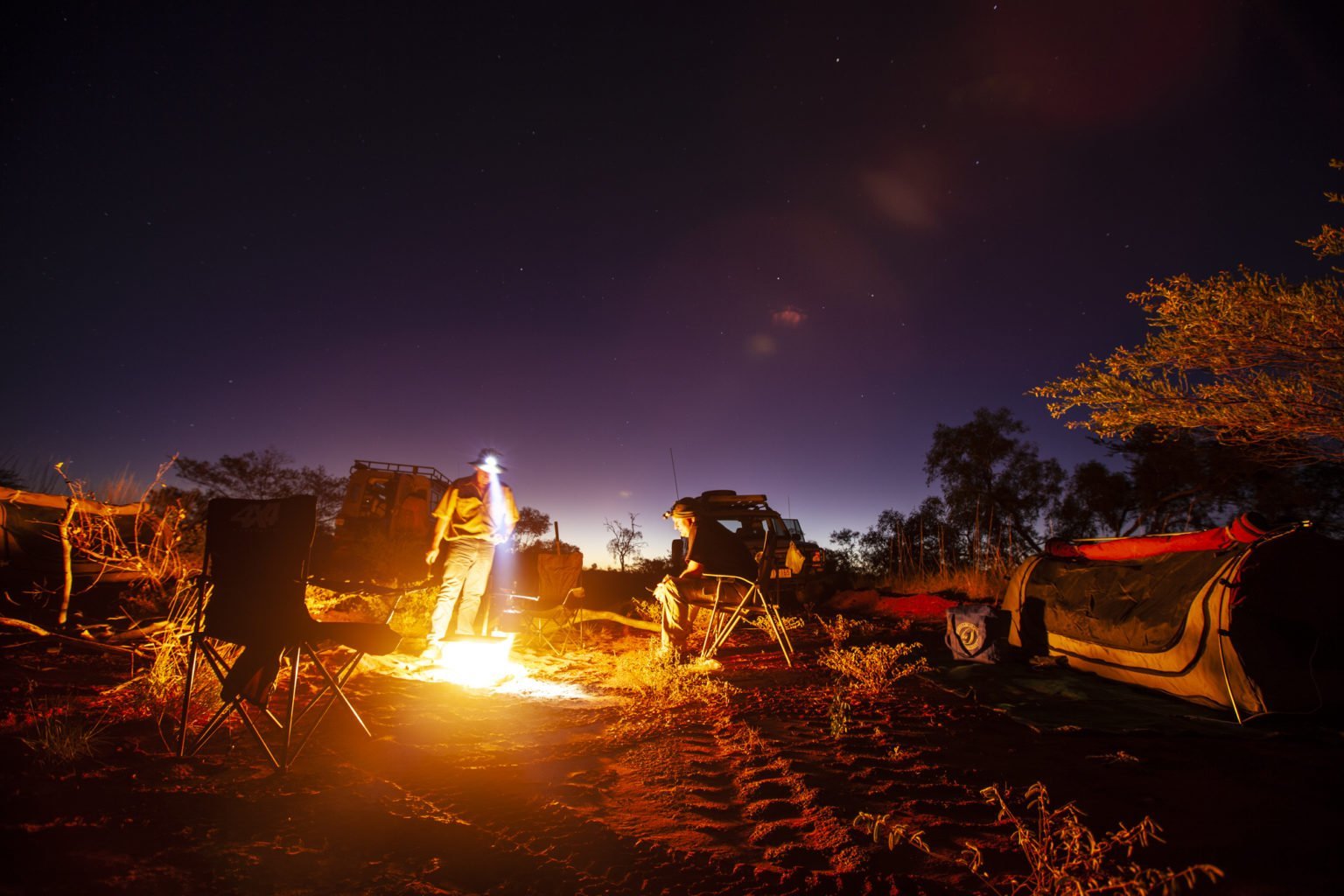
The other appeal is that, rather than being ‘the same thing every day’, a week or two (or longer) exploring one or more of Australia’s outback regions, really brings home how unique each of them is, in terms of the wildlife, Indigenous links, terrain, camping, the driving challenge and plenty more.
Yeah, it sounds impossibly romantic; packing the 4WD and heading to points unknown, but that notion of outback escapism needs to be, firstly, backed by a whole lot of research, planning and preparation, including perhaps upgrading your vehicle. Once that is out of the way – and the actual pre-trip prep can be more than half the fun – is when the real adventure starts. Let’s go…
Vehicle choices
Outback travel is punishing on vehicles due to the usually rugged tracks and roads, as well as the potential for water-crossings and steep, slippery tracks that need to be negotiated carefully. This all points to a 4WD as being the only choice for those who wish to experience the more remote (and beautiful) parts of Australia – you may need car loan to upgrade your existing vehicle . While the lure of a new vehicle with the latest mod-cons is all too real, try to exercise restraint and think realistically about both what you require and can afford. Seeking pre-approval for vehicle finance can be a good way to ensure you’re sticking within your budget, should you be looking to buy.
In terms of motivation, diesel engines are still the number one choice for long-distance remote touring, due to better fuel economy than the equivalent petrol engine, and the availability of diesel in very remote areas.
Then, you need to decide whether you go for a 4WD ute or a 4WD wagon and that choice is not always straightforward…
The outback workhorse
The 4WD dual-cab ute is probably the most popular option for serious and regular outback tourers. This is due to a number of reasons, starting with the fact these utility vehicles can carry a considerably heavier load than a 4WD wagon in the rear tray. That rear tray also adds always-welcome cargo storage space for travelling families: with the simple addition of a canopy (a hard shell that covers the ute tray) you gain copious storage space – far more than you will find in a wagon. Utes are built to lug heavy loads so are considerably robust, but they are longer and there are certain sacrifices you make if you opt for one. Chief among this is, even though they have improved immensely, utes do not offer as comfortable a ride for passengers as a 4WD wagon does. This is due to the firm rear suspension (usually ‘old school’ leaf-springs) that have to be quite stiff/firm so they can cope with those heavier loads.
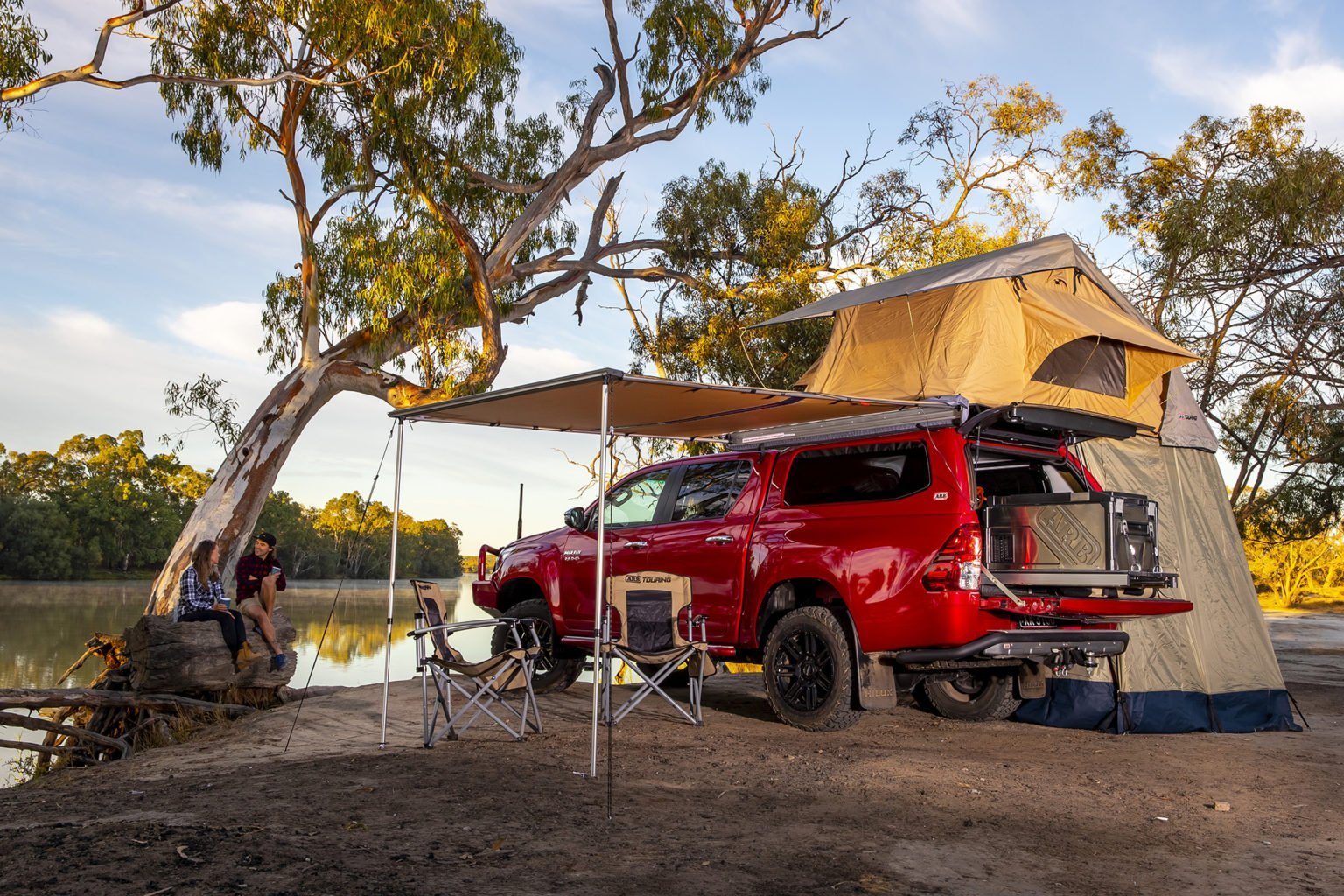
For families, the rear seat of a dual-cab (four-door) ute is, today, a better place to spend time in, but still not as comfortable as the second-row seating in a wagon, where most second-row seating these days can be tilted back for more comfort (a ute’s second row cannot). Still, a properly set up ute, with a spacious canopy that houses a cargo-drawer system for storing all essential gear, a fridge/freezer, auxiliary power setup, all your dusty camping gear, and further (light) gear loaded up on top on a roof-rack, makes for a formidable – and reliable – outback touring vehicle.
Circle the wagons
If you opt for a more comfortable 4WD wagon, you will have to work with less cargo space and a lower maximum payload figure (the legal amount of weight a vehicle can carry). But you will gain more security for your gear in the back, that aforementioned additional comfort for the kids, and a more supple ride overall, thanks to the use of coil spring suspension all-round (rather than the firmer leaf-spring rear suspension found on a ute). You will, as mentioned, have to pack more cleverly – and with that payload figure always in mind. As an example, most popular large 4WD wagons these days (think: Toyota’s LandCruiser or Prado; Ford Everest; Isuzu MU-X) have payload figures around the 600-650kg mark, compared to a ute’s 900-1000kg. Add a set of sturdy cargo-drawers, fridge/freezer, roof-rack, bull bar and driving lights, camping gear, food, water and yourselves to a 4WD wagon and you will soon be close to that maximum payload figure. (Some 4WD wagons do have higher payloads – the Land Rover Defender, at 850kg-plus, is an example.)
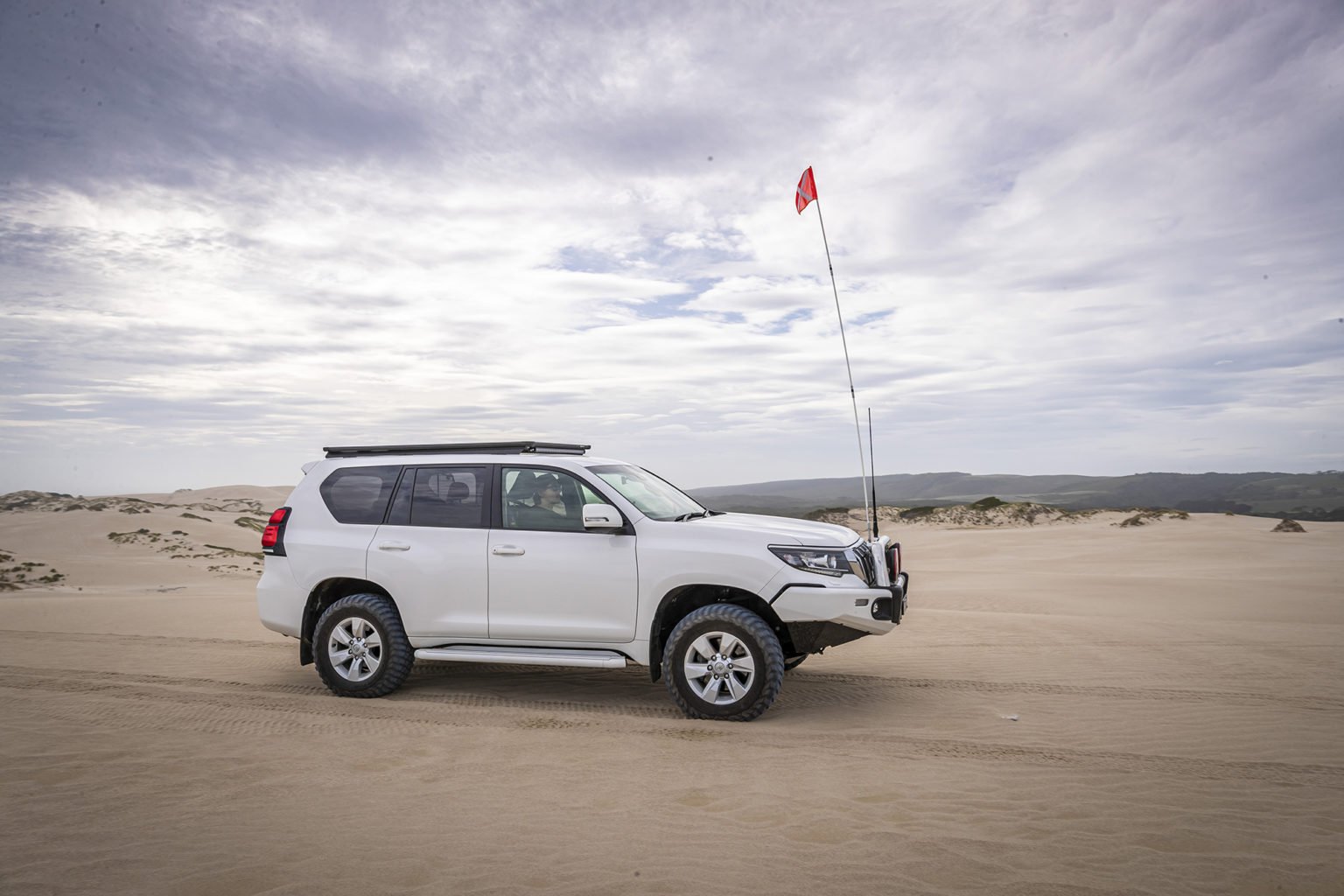
To ensure you can fit in all of the right camping gear , look for lighter-weight equipment, i.e., instead of two heavy canvas swags or a big canvas touring tent, look at lightweight alternatives (hiking tents, for example). There’s a tendency to throw every accessory on a 4WD but this is often overkill. A good example is cargo drawer systems. These are very handy, but you can set up a similar storage system in the back using robust plastic boxes that are lighter – you just have to make sure it ‘works’ effectively in terms of being able to reach and unload essential camping gear quickly once you arrive at your destination.
Vehicle essentials
For those contemplating an outback trip of, say, a couple of weeks or longer, there are a few accessories that will considerably enhance the overall experience. Here are our top five.
Fridge/freezer. These are brilliant. Running it off a portable power pack or an auxiliary battery system – or a portable solar panel setup at camp, means your food stays fresh and your drinks cold. If you can fit one in, a dual-compartment fridge and freezer unit (one compartment runs as the fridge, the other a freezer) is the best option. All-terrain tyres. Nearly all 4WD wagons and utes come with road-biased tyres, due to the fact that even the most prolific outback travellers will still spend more time on the road. An all-terrain tyre features more robust construction and a chunkier tread pattern to ensure optimum traction on slippery or muddy surfaces. Plus, the thicker sidewalls increase protection against staking/puncturing. Tyre repair kit. These are invaluable. Easy to use, a tyre repair kit can mean the difference between being stranded and getting back to civilisation. Aftermarket suspension. For those who will spend considerable time on rough tracks, an aftermarket suspension setup is worth the price. These are designed specifically for rougher road surfaces and are stronger and more effective at providing a comfortable and safer ride. Driver training. Modern 4WDs are very easy to drive on the road – no different to a regular car or station wagon – but if you intend using them for what they are designed for, we thoroughly recommend a 4WD driver training course. You will learn just how your vehicle works off-road (and why), and also how to drive to challenging conditions.
Planning sure does pay
For this writer – and I am sure for most adventurers – poring over a series of maps is an integral part of the trip planning process, regardless of your destination. With a focus on remote outback travel, having access to a number of maps – and accurate ones – is key to effective trip preparation*. The reasons are many and include the obvious of seeing where your destination is, in relation to where you’re starting point, along with giving you a great overall ‘visual’ of the country you will be covering in terms of access tracks, refuelling points (whether in towns, Aboriginal communities, or likely fuel drop-off/caching points), whether there are any water sources in the region, and – of course – the total distance of the route/track you will be following.
*While online mapping websites are great when you’re at home, they can be unreliable once you’re out of mobile phone range. There are many GPS mapping solutions; consider, too, going “old-school” with physical paper maps.
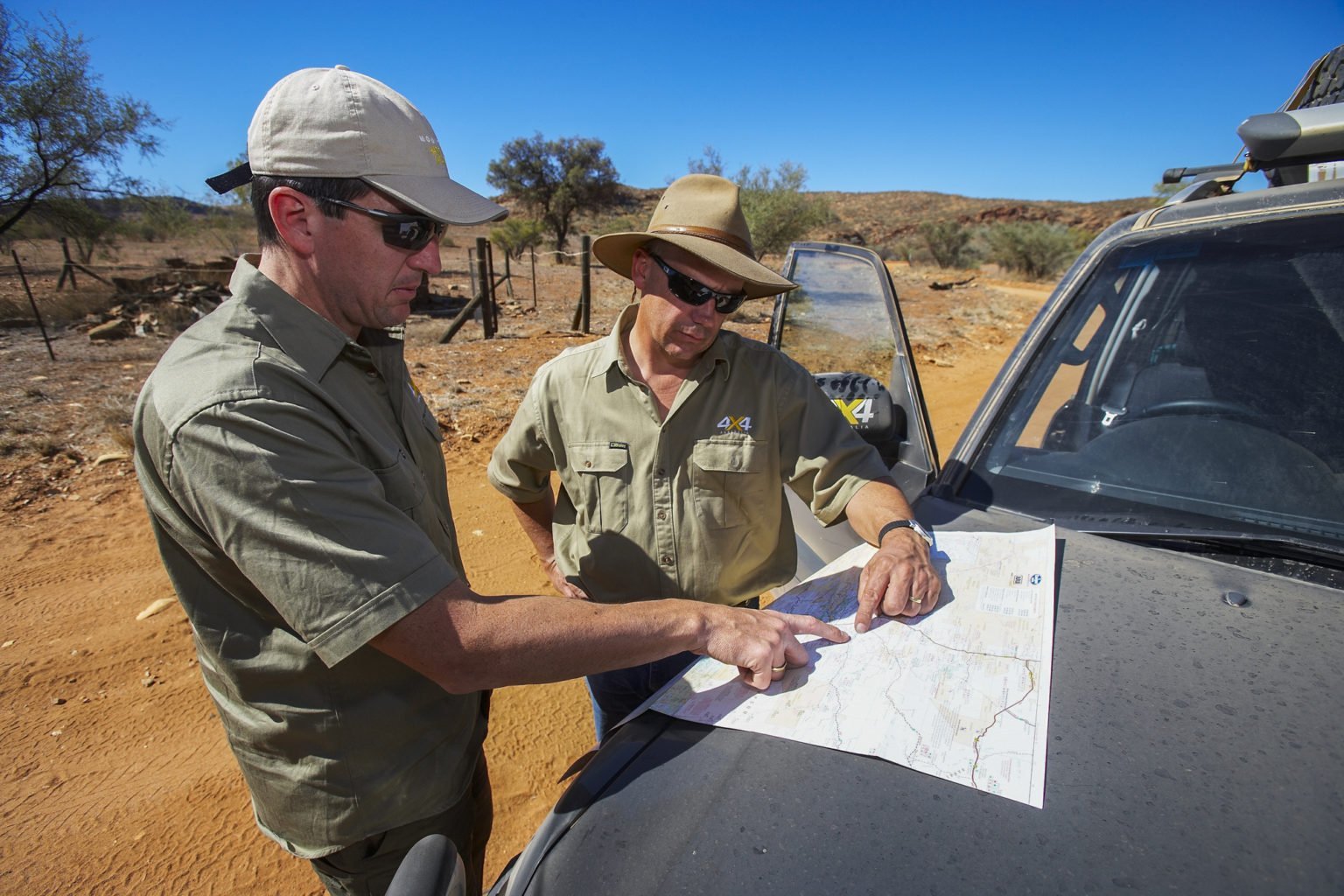
Large area maps are your best starting point (think: Hema’s excellent Great Desert Tracks maps ), and from there you can move down in map scale and also start using digital mapping (websites and/or apps and GPS units). The key consideration here is how you’re going to navigate when out of mobile phone range and in case of an emergency.
Some, but not all, of Australia’s deserts are comprised of both national parks and Aboriginal-owned land, and one of the first checks you do need to do is that based around any essential permits you may need to traverse these lands. Most states’ national parks and the various Indigenous land councils have online permit systems that are, generally, pretty easy to access and fill in. Some permits may take longer to acquire than others, though, so bear that in mind and make sure you give the relevant authorities plenty of notice of your travel dates. By doing this it allows any communication to and from regarding your trip plans to be undertaken, thus ensuring the relevant authorities know exactly where you are – and how long for. As an example: this writer had a potential Arnhem Land trip quashed years ago after gaining approval from the Traditional Owners thanks to plenty of transparency in communication, only to have it stopped by a tie-wearing office-bound bureaucrat in Darwin. Just sayin’…

Never run dry
With the distances and remoteness of Australia’s deserts, planning for a trip here involves accounting for a number of unique factors, starting with one of the essentials: fuel usage for your vehicle – and yourselves.
Think of some of the longer desert tracks in Oz, such as the 1619km Canning Stock Route (CSR) or the 1324km Anne Beadell Highway, and you soon realise an accurate estimate of fuel consumption is crucial to a successful and safe adventure. As most know, any vehicle will use more fuel when driven on unsealed surfaces. Add in the mechanical effort needed to push a two-tonne-plus vehicle through sand and you will need to factor in far heavier consumption than ‘normal’. If you have a hungry vehicle at the best of times, perhaps now’s the time to look into upgrading to something more economical for on-road so your off-road fuel costs aren’t ever higher.
This would also be a good time to check on maps and/or any online resources as to the longest distance between re-fuelling points. As an example, the distance between fuel points on the CSR is a heady 977km, necessitating the planning of a fuel drop or two. Some travellers (mostly, but not exclusively), will have the capacity to lug the required amount of fuel – usually in jerry cans, sometimes in addition to a fitted aftermarket long-range tank – but that will depend on your vehicle’s load-carrying capacity. The temptation is to put jerrys up on the roof-rack, but the additional load up high does affect vehicle handling. You will need to check not your roof-rack load capacity, but the manufacturer’s maximum permitted load for the vehicle’s roof. You might be surprised how little that burly 4WD wagon of yours is legally allowed to carry up top. An alternative to roof-stored fuel is to fit an aftermarket rear bar that incorporates twin jerry-can holders (or, a single jerry holder and spare wheel carrier).
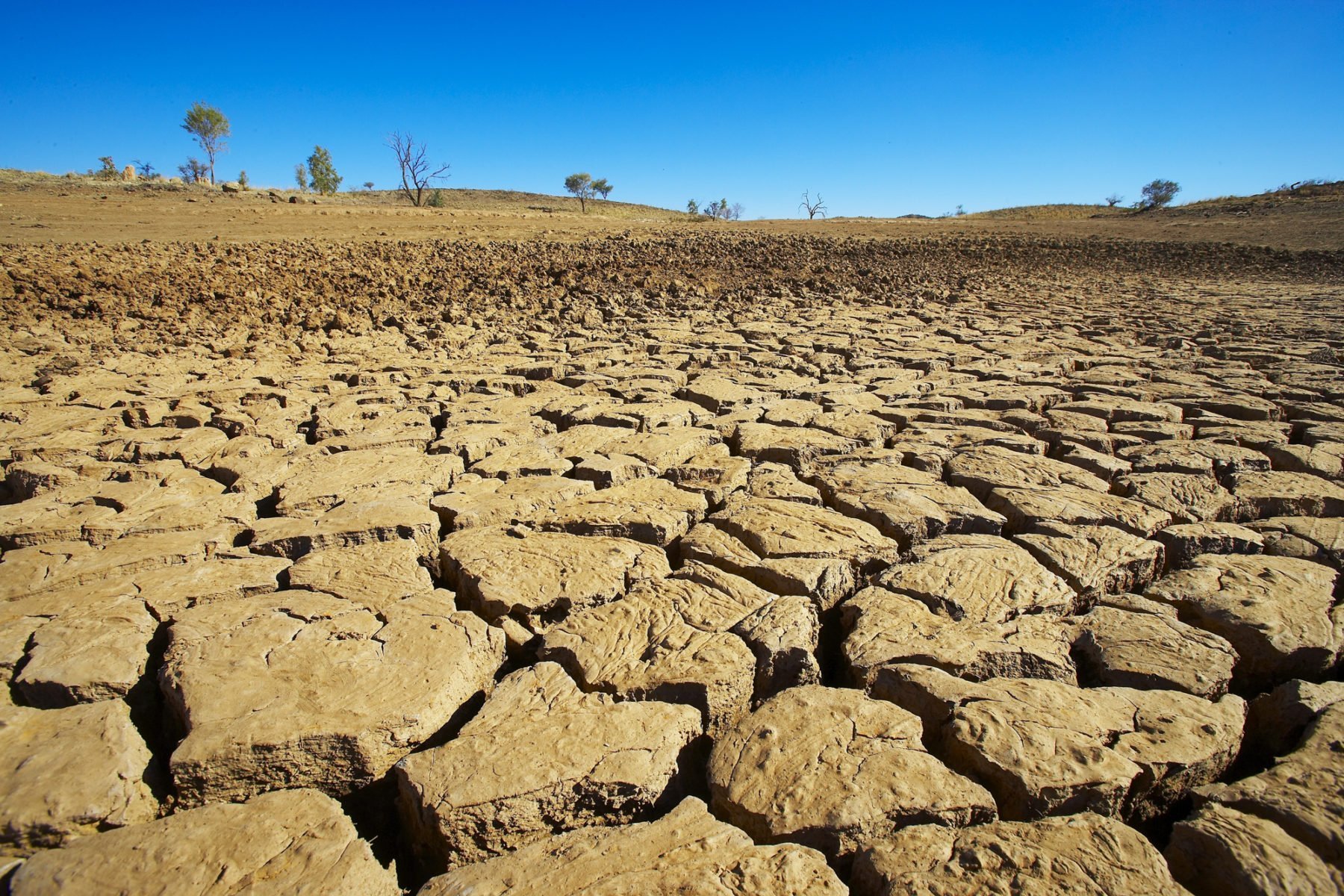
The other liquid essential on any desert trip is water. And by this we mean not only having enough water on-board for keeping everyone hydrated, but for other essential activities, such as cooking, washing up, personal hygiene and potentially having to top-up vehicles’ radiators. Again, distance (and amount of resupply points) plays a part in estimating how much you will need, but we’d recommend at least 20 litres per day, per person. Yep, that sounds a lot, and it soon adds up in terms of weight and eating into your vehicle’s load capacity. However, in this instance, it’s best not to quibble. A further tip that applies to both water and fuel storage is to ensure your jerry cans/containers are in excellent condition and that you don’t store all the liquid in one or two containers. If the unfortunate does happen and it springs a leak, you could lose a significant portion of your water/fuel supply – something to be avoided anywhere, but especially in arid country.
Perpetual motion
Safe outback travel means having a vehicle that is set up for the conditions and in tip-top mechanical condition. This is one of the first things that needs addressing as you plan your dream escape. A full going-over by a mechanic who specialises in outback travel prep is a must; checking for suspension (and tyre) wear and tear, as well as ensuring all the hoses and fitments in the engine bay are in robust condition and that all accessories are securely – and correctly – fitted, will mean you have already significantly reduced the chances of breaking down. The next step will be for them (and you) to draw up a list of essential spare parts that you will need to carry in the event that something does break – and this may still happen regardless of how ‘new’ the fitted parts are; the desert, in particular, is unforgiving. We’re not all accomplished bush mechanics (tip from this writer: travel with one if you can!) but more basic repairs, such as how to plug a punctured tyre (yep, a puncture-repair kit is another must-pack), should be within your skill-set if you plan on spending time in remote areas.
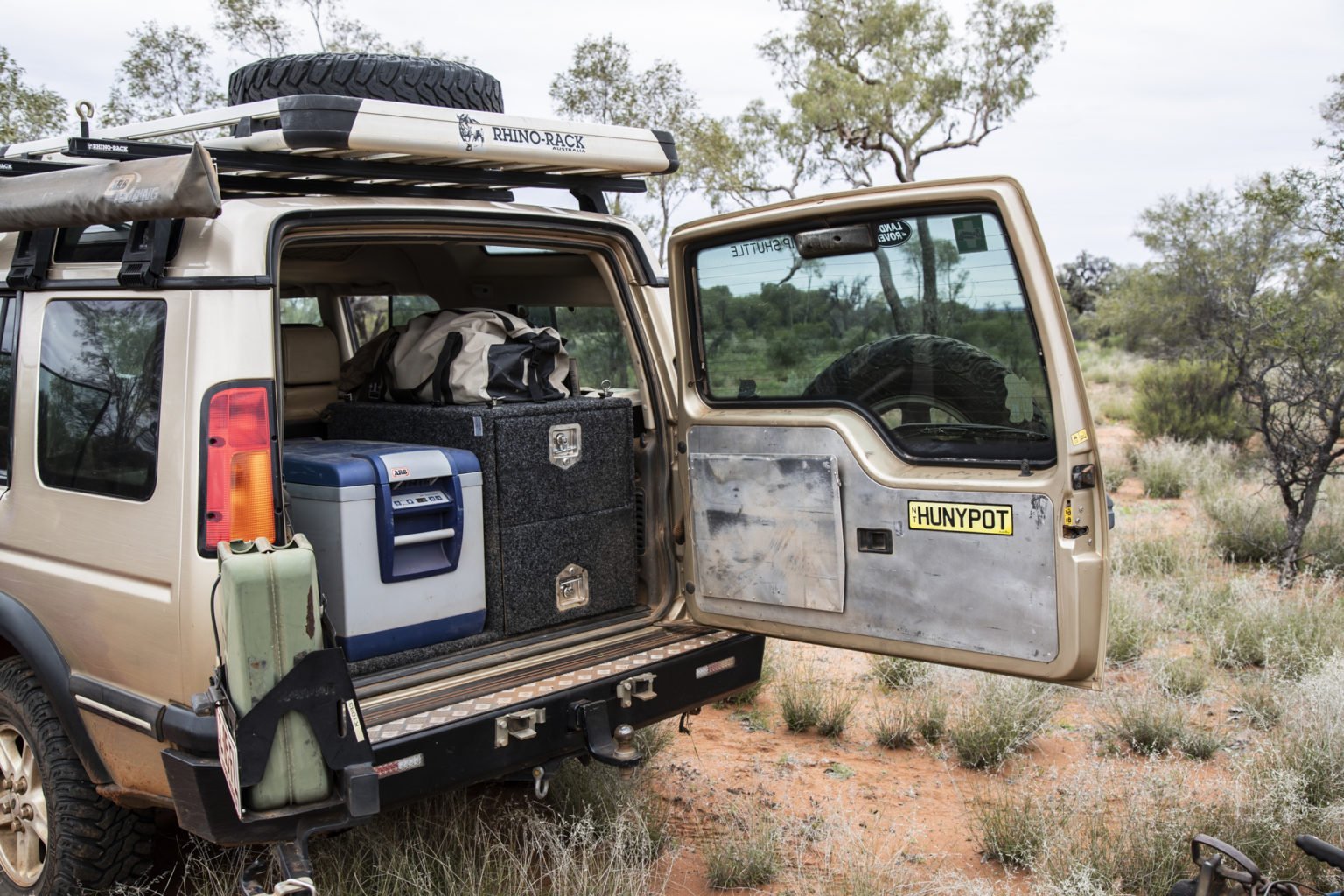
One near-essential is a second spare wheel/tyre; rough tracks can be murder on even the toughest tyres. Even though tyre plugs can work miracles, if you tear a tyre sidewall, the plugs don’t work; having a second spare brings additional reassurance and ups the safety factor when you are, literally, many miles from anywhere.
Driving through desert country usually means negotiating myriad dunes and these are often taller/deeper than your vehicle. Fitment of a sand flag is non-negotiable as it assists any oncoming traffic being able to see you, thus avoiding a head-on collision. Packing specialist sand-recovery gear – on top of your normal recovery kit, which should include snatch straps, shackles, ropes, gloves, tyre levers, jack, etc. – is another must. A set (or more) of Maxtrax offers great insurance for those driving over sandy tracks. These are very robust and also very easy to use. Plus, they don’t weigh much, offering excellent recovery bang-for-bucks.
The final piece of the vehicle puzzle is an effective communication setup. Not only does a reliable UHF radio (or Satphone ; this is more for any emergency situation, as is a Personal Location Beacon) ensure you’re never totally stranded if the worst-case scenario eventuates; being able to call on the channel occasionally to see if there is any other traffic approaching helps reduce further the chance of a vehicle-on-vehicle incident.
Speaking of which, it goes without saying that at least one, but preferably more, of your expedition crew should have the latest Remote First Aid training – and a comprehensive First Aid kit should be packed.
Outback basecamp
Nothing beats pulling up in the middle of the desert in the evening, cooking up a storm and enjoying a few cold drinks as the sun sets over the dunes. That sounds like a dream scenario but, as long as you have the required remote power requirements to keep the lights glowing and the fridge cool, you’ll get to enjoy that dream-like outback dining experience every night on your outback adventure.
It does all come down to power. To this end, it’s worth expanding your regular off-road power options, such as a dual-battery setup or portable power pack, to include portable solar panels. These are relatively cheap, reliable and pretty much a standard inclusion on outback travel equipment lists. With the outback touring season usually the time of clear days – every day – being able to set up solar panels at camp renders the question of reliable power moot. There are myriad solar panel systems available, so you will need to research what suits your particular requirements. Also worth tackling is a course on basic auto-electrical repairs – or at least having some knowledge of how your vehicle’s auxiliary power setup works in case you have to troubleshoot power-related problems.
Travelling with a portable fridge means you will be able to keep food fresh for a decent amount of time in the desert. Making it last longer is possible by selecting a fridge/freezer combo unit , where a portion of the fridge is a dedicated freezer. Another trick to ensure fresh grub for longer is to get your local butcher/food supplier to cryo-vac your meat. By vacuuming all the air out of the container, the use-by date of meats in particular can be extended significantly.
Don’t forget you’re on outback time
One thing often forgotten in the dreaming, researching and final planning of the big outback adventure is just how much time it can take. Driving in sand, especially, is where you need to balance momentum and patience, and also where you need to realise it will take longer to negotiate numerous dunes than it would to traverse a long, straight outback road.
Even though the actual distance between two points may be ‘not that long’, driving in soft sand, having to perform the occasional recovery, and stopping to take in your surrounds, all takes time – and makes for the perfect excuse not to rush. There’s no reason you can’t stay at, say, Camp 15 on the Madigan Line for more than one night (and same applies to that speccy campsite at Cape York ), as you’ve spent months and lots of money planning and prepping to get yourself out to a destination few people will ever experience, so make sure you allocate enough time to soak it up properly. After all, you’ll be on ‘outback time’, in a place that has seen thousands of years of Indigenous inhabitants and a few hundred years of explorers traversing it. We’re sure it – and you – will cope with spending a little bit of time out there…

Alone Australia’s Duane Byrnes talks adventure and environment
With the second season of Alone Australia on our screens now, there’s no better time to check in with one of the inaugural season’s most popular participants, Duane Byrnes.

A private audience with the land of ice: Kayaking in Antarctica
Using a sea kayak to explore remote parts of Antarctica’s coastline and view its unique wildlife adds an intimate feel to a visit to the White Continent.

ACTing loopy: Cycling the Canberra Centenary Trail
There’s more to Canberra than politics, as Dan Slater discovers on a four-day cycling loop of the nation’s capital.
Watch Latest Web Stories
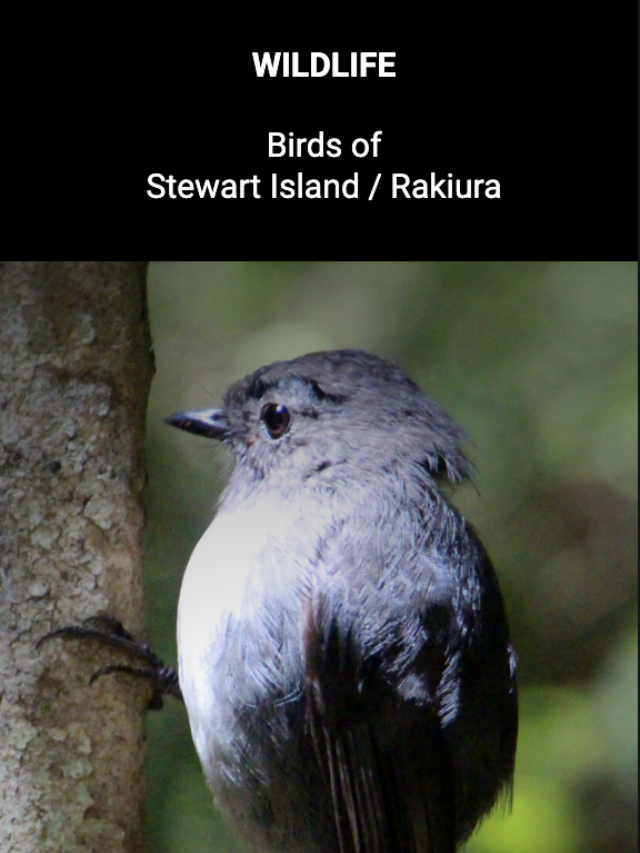
Birds of Stewart Island / Rakiura
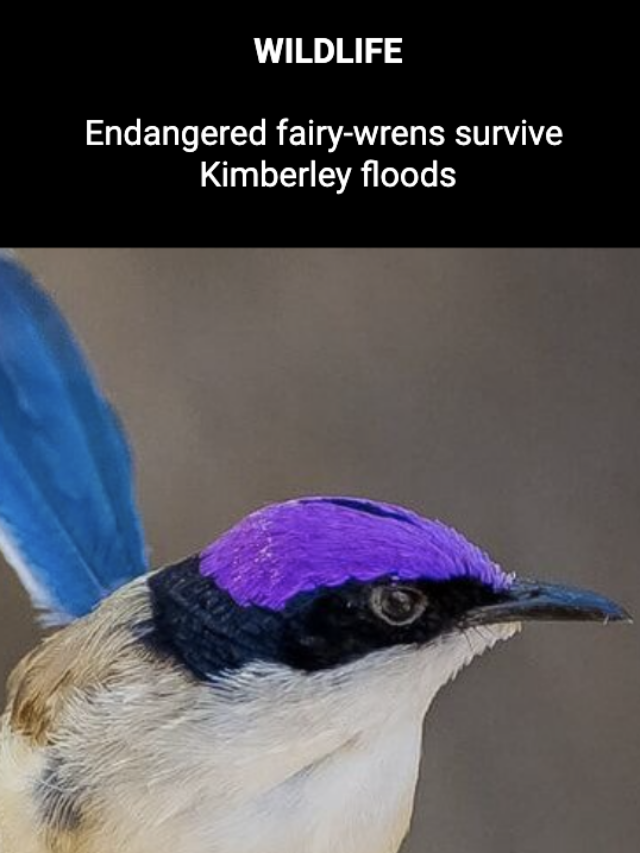
Endangered fairy-wrens survive Kimberley floods
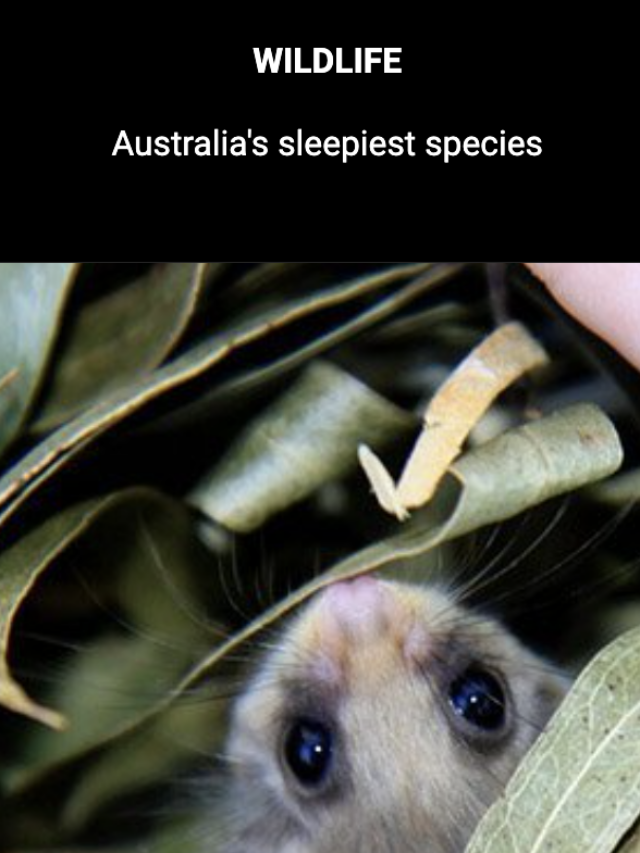
Australia’s sleepiest species

2024 Calendars & Diaries - OUT NOW
Our much loved calendars and diaries are now available for 2024. Adorn your walls with beautiful artworks year round. Order today.

In stock now: Hansa Soft Toys and Puppets
From cuddly companions to realistic native Australian wildlife, the range also includes puppets that move and feel like real animals.
ADDR: U6, 13A Elite Way, Carrum Downs VIC 3201 | PH: 0481 815 760

Shop » Maps & Guides » Four Wheel Drive » Outback Travellers Googs Track Series 4 – Track 3

Outback Travellers Googs Track Series 4 – Track 3
$ 22.00 inc GST.
Googs Track was built by ‘Goog’ and ‘Dinger’ Denton along with Denis Beattie (Jenny Denton’s brother) from June 1973 through to August 1976.

Description
- Reviews (0)
Googs Track Guide covers a total distance of 368.7km. Googs Track provides 4 Wheel drivers with a great means to seek adventure and experience a virtual ‘mini’ Simpson desert.
Travelling over roughly 300 sand dunes climbing up to 25 metres, will test your driving skills with sand whilst taking in some pristine country through the Yumbarra Conservation Park and Yellabinna Regional Reserve.
Googs Lake and Mt Finke offer popular camping locations with a relaxing environment. Although travel from South to North is recommended, this is a two-way track and drivers need to be aware of on-coming 4wds.
The Sectioned Maps will help you find everything of interest along the Track and point out potential road cautions in advance, supported by visual references, for the benefit of your safety.
Using photography, track notes and mapping, the Outback Travellers Canning Stock Route Track Guide is a companion to sheet maps, offering a closer look at what is out there, where to find it and how to get there safely.
Map Guides include:
- Ceduna to Yumbarra Conservation Park Gate, 30.3km (Section A)
- Yumbarra Conservation Park Gate to Googs Lake, 50.8km (Section B)
- Googs Lake to Track Marker Number 110, 34.5km (Section C)
- Track Marker Number 110 to Mt Finke, 44.4km (Section D)
- Mt Finke turnoff to Trans Australia Railway, 37.1km (Section E)
- Trans Australia Railway crossing to Tarcoola, 48.4km (Section F)
- Tarcoola to Kingoonya, 80.4km (Section G)
- Kingoonya to Glendambo, 42.8km (Section H)
General maps include Ceduna.
NOTE: 8 pages of this guide are advertising. North does not always point up, however it is clearly marked on each map.
Additional information
Outback travellers.
There are no reviews yet.
Your email address will not be published. Required fields are marked *
Your review *
Name *
Email *
Related products

Central Australia 4WD Explorer Map – Hema

Cape York 4WD Map – Old Telegraph Track – Hema

Pilbara 4WD Explorer Map – Coral Coast – Hema
Product categories.
- Battery Packs (6)
- Compasses (4)
- Emergency (6)
- Hiking Poles (46)
- Lighting (39)
- Miscellaneous (39)
- Pack Covers (2)
- Tent Pegs (1)
- Camping (12)
- Four Wheel Drive (31)
- Hiking Trails (32)
- Outback (4)
- Touring (20)
- Travel Guide (15)
- Gaiters (10)
- Ponchos (3)
- Rainwear (2)
- Thermal (4)
- Map Packs (4)
- New South Wales (25)
- Queensland (2)
- South Australia (17)
- Tasmania (15)
- Vicmap 25K Scale (48)
- Vicmap 50K Scale (88)
- Victoria (97)
- Western Australia (1)
- Bowls Plates & Cups (22)
- Cooking (74)
- Cutlery (10)
- Four Wheel Drive (88)
- Information Maps (1)
- Map Guides (47)
- Map Packs (5)
- New Zealand (5)
- Touring Map (101)
- Tourist Maps (25)
- Vicmap 100K Scale (70)
- Wall Maps (17)
- Accessories (4)
- Hammocks (7)
- Liners (10)
- Pillows (10)
- Compression Sacks (7)
- Day Packs (7)
- Dry Sacks (18)
- Duffle Bags (1)
- Miscellaneous (5)
- Trekking Packs (1)
- Water Bladders (51)
- Waterproof Cases (1)
Fire Danger Info
- MyFireWatch Australia Bushfire Map
- ACT Emercency Services Agency
- NSW Rural Fire Service
- NT Bushfire Alerts & Warnings
- Queensland Current Bushfires
- SA CFS Warnings & Incidents
- Tasmania Fire Service Map
- VIC Emergency Incidents & Warnings
- Emergency WA Warnings & Incidents
About Green Trails
Green Trails Australia was founded by Michael Pieper who started hiking in Hong Kong from 2002. Since 2016, Michael has continued his hiking adventures around Victoria & Australia.
Our goal is to build a community of avid walkers & hikers, with detailed hiking trail guides & regular Meetup Events . Walking for exercise is the top participation in sport & physical recreation in Australia, let’s make hiking the second most popular!
Work with Us
If you would like to be part of the action here at Green Trails Australia, send us an email at [email protected]
All product reviews found on our site will be based on real life testing and will be honest and true.
If you have an event that you would like mentioned on Green Trails Australia, let us know and we would be happy to work with you to promote it on our website.
Free shipping over $75 and on all map orders Australia wide
Credit card Secure Positive SSL
(c) 2018 Green Trails Australia - ABN 99 549 421 353
- Orders & Shipping
- Returns & Warranties

IMAGES
COMMENTS
The Outback Travellers Track Guide. Covering a vast majority of the Central Australian Outback with detailed safety instructions. MAP SHOP . Video not supported. Experience the Outback's magic with THE ULTIMATE TRACK GUIDE. Our map guides are not cluttered with unnecessary detail, but focus on the track you are driving and what you will ...
The Outback Travellers Guide series of map booklets have been around for a few years now. These spiral bound guides are full of the kind of detailed track information that many 4WDers on remote tracks would love - everything from bulldust ruts, creek crossings to potential campsites in sand dune swales are covered.
Showing 1 to 30 of 30 (1 Pages) Back to Top. From Maptopia, the Outback Travellers Track Guides have 4WD maps and additional valuable information for the popular outback tracks such as the Birdsville Track, Canning Stock Route, Binns Track, Alice Springs to Yulara.
Great Central Road Outback Traveller's Track Guide Covers: Yulara, Docker River, Warakurna RH, Giles, Warburton RH, Tjukayirla RH, Cosmo Newberry, Laverton. The Great Central Road, now part of 'The Outback Way', not only offers travellers a short cut from the West to Central Australia but highlights the vast desert regions of this part of ...
The Outback Travellers Track Guide. 4,497 likes. Welcome to the OFFICIAL The Outback Travellers Track Guide® Facebook page!
The Outback Travellers Track Guide Series 1: Oodnadatta, Strzelecki and Birdsville Tracks. Westprint Birdsville & Strzelecki Tracks, also Oodnadatta Track. SUPPLIES. Comprehensive supplies in Port Augusta. Scripts and medical supplies are not available anywhere else. Carry a first aid kit. Limited supplies are available along the way.
Using photography, track notes and mapping, the Outback Travellers Oodnadatta Track Guide is a companion to sheet maps, offering a closer look at what is out there, where to find it and how to get there safely. Map Guides include: Muloorina Road to Level Post Bay, 96.4km (Lake Eyre North) Marree to Lake Eyre South, 83.1km (Section A)
Tanami Road Outback Travellers Track Guide. Coverage: Alice Springs, Tilmouth Well Roadhouse, Yuendumu, Rabbit Flat, Balgo, Billiluna, Halls Creek, Old Halls Creek, Bungle Bungle. The Tanami Road Track is a major link between Central Australia and North West Western Australia, commonly known as the Kimberley.
Using photography, track notes and mapping, the Outback Travellers Birdsville Track Guide is a companion to sheet maps, offering a closer look at what is out there, where to find it and how to get there safely. Map Guides include: Marree to Clayton Wetlands, 52.9km (Section A) Clayton Wetlands to Russells Creek, 39.7km (Section B)
The Outback Travellers Series Two covers Central Australia up to the Top End of Northern Territory. Binns Track Guide covers a total distance of 2180km. Adventurous 4 wheel drivers will endure everything from deep bull dust to bitumen, rocks to water crossings and travel through desert, hills, National Parks and townships.
Using photography, track notes and mapping, the Outback Travellers Davies Plain Track Guide is a companion to sheet maps, offering a closer look at what is out there, where to find it and how to get there safely. Number of Pages: 26. Map Guides include: Omeo to Benambra, 22.6km (Section A) Banambra to Beloka Road, 15.7km (Section B)
About Outback Travellers Track Guides; Our Story; Trip Preparation; Series 1 Series one covers covers 6 major tracks: Overview; Birdsville Track; North Simpson Desert; Oodnadatta Track; Outback New South Wales; Simpson Desert; Strzelecki Track; ... Outback Guide. Series 4. Anne Beadell Highway.
Googs Track. Buy The Track Guide. Googs Track was built by 'Goog' and 'Dinger' Denton along with Denis Beattie (Jenny Denton?s brother) from June 1973 through to August 1976. A mammoth task by men with a true pioneering spirit. The track today provides 4 Wheel drivers with a great means to seek adventure and experience a virtual 'mini' Simpson ...
Using photography, track notes and mapping, the Outback Travellers Strzelecki Track Guide is a companion to sheet maps, offering a closer look at what is out there, where to find it and how to get there safely. Map Guides include: Lyndhurst to Yerilina Creek, 74.5km (Section A) Yerillina Creek to MacDonnell Creek, 81.7km (Section B)
7 Weeks 13,222km Brisbane, Winton, Alice, Ayers Rock, Willuna, CSR, Halls Creek, Darwin, Mataranka, Alice, Simpson Desert, Birdsville - Big Red Bash.. few parks on ...
Outback Traveller's Guide 2024. Check out this guide for ideas to plan your trip, including some of our'must do' new experiences and family-friendly activities. If you love nature and views then don't miss the opportunity to take a drive, scenic flight or hike, or visit some of our award-winning events and encounters unique to the region.
Using photography, track notes and mapping, the Outback Travellers The Pilbara Track Guide is a companion to sheet maps, offering a closer look at what is out there, where to find it and how to get there safely. Map Guides include: Broome to Eighty Mile Beach, 418.1km (Section A) Eighty Mile Beach to Port Headland, 292.8km (Section B)
Outback travel: The ultimate family guide. Checking out sunset at Seven Emu Station, in the Gulf region of the Northern Territory. Image credit: Justin Walker Image credit: Justin Walker. Exploring the outback is a rite of passage for adventurous Aussie families. Here's all you need to know for a successful and fun experience.
Googs Track Guide covers a total distance of 368.7km. Googs Track provides 4 Wheel drivers with a great means to seek adventure and experience a virtual 'mini' Simpson desert. ... Using photography, track notes and mapping, the Outback Travellers Canning Stock Route Track Guide is a companion to sheet maps, offering a closer look at what is ...